Working in Partnership: Mr. Ian Case Study
VerifiedAdded on 2024/05/14
|22
|5459
|280
AI Summary
Explore the complexities of partnership working in the health and social care sector through the case study of Mr. Ian. Understand the philosophies, evaluation, legislation, barriers, and strategies for effective collaboration.
Contribute Materials
Your contribution can guide someone’s learning journey. Share your
documents today.
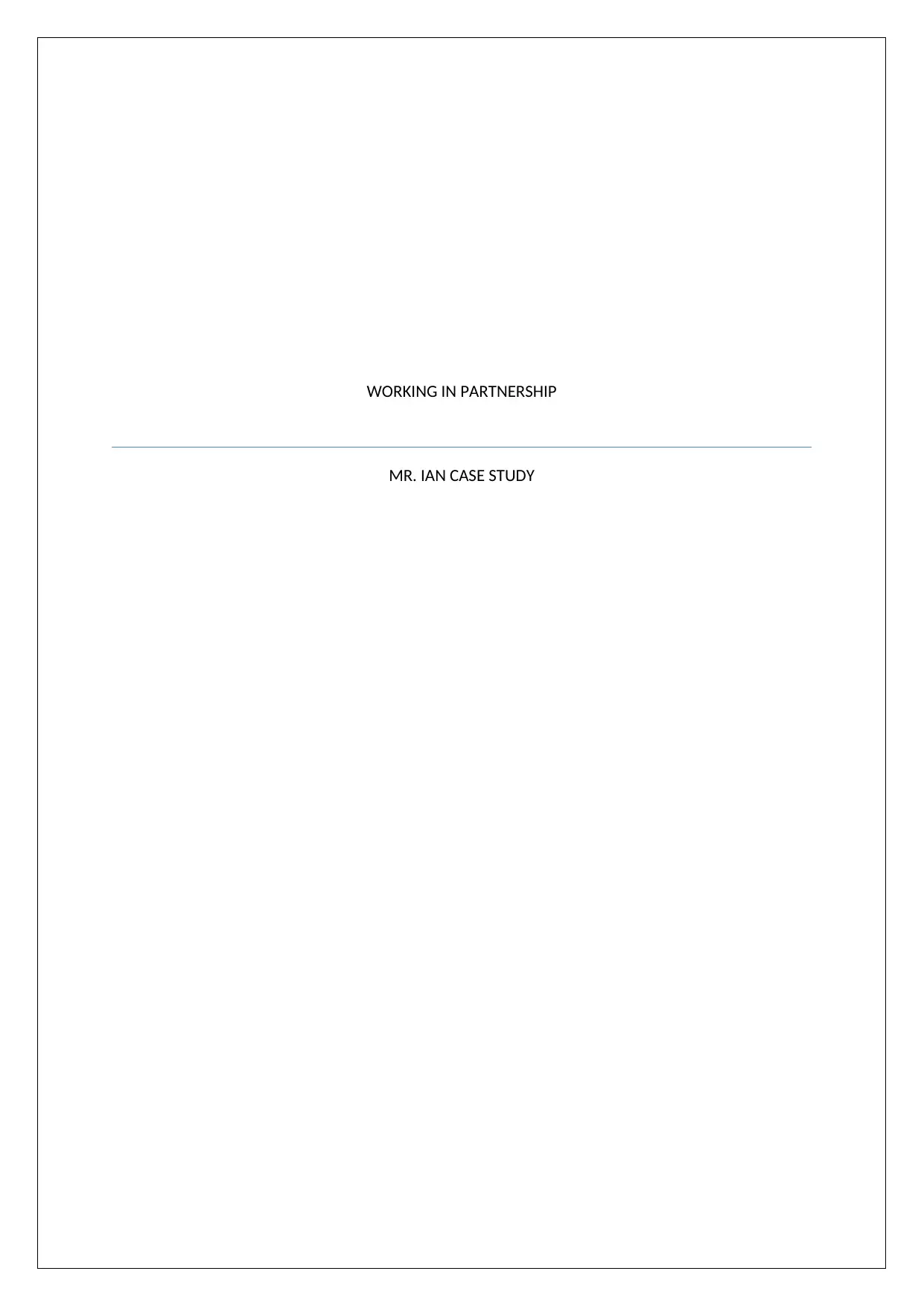
WORKING IN PARTNERSHIP
MR. IAN CASE STUDY
MR. IAN CASE STUDY
Secure Best Marks with AI Grader
Need help grading? Try our AI Grader for instant feedback on your assignments.

1

INTRODUCTION
The health and social care industry is rapidly growing industry in the country and in recent
years, various organizations and institutions have chosen for partnership working for
facilitating the delivery of best and quality services to the people. A partnership is a mutual
and collaborative relationship between the two or more parties which is basically based on
equality, trust and mutual understanding between the parties for achieving a particular
common goal. Every partnership requires equally accountable and shared level of trust and
interdependency and involves some benefits and risks. In health and social care sector, the
working in partnership brings separate organizations together for to gain the benefit of
varied resources, expertise and power for enhancing and improving the services quality in
the sector (Nyström et al., 2018). This assignment project will provide information and
knowledge about the various aspects of working in partnership with health and social care
sector with considering the case study of Mr. Ian to gain a better understanding of the
subject.
2
The health and social care industry is rapidly growing industry in the country and in recent
years, various organizations and institutions have chosen for partnership working for
facilitating the delivery of best and quality services to the people. A partnership is a mutual
and collaborative relationship between the two or more parties which is basically based on
equality, trust and mutual understanding between the parties for achieving a particular
common goal. Every partnership requires equally accountable and shared level of trust and
interdependency and involves some benefits and risks. In health and social care sector, the
working in partnership brings separate organizations together for to gain the benefit of
varied resources, expertise and power for enhancing and improving the services quality in
the sector (Nyström et al., 2018). This assignment project will provide information and
knowledge about the various aspects of working in partnership with health and social care
sector with considering the case study of Mr. Ian to gain a better understanding of the
subject.
2
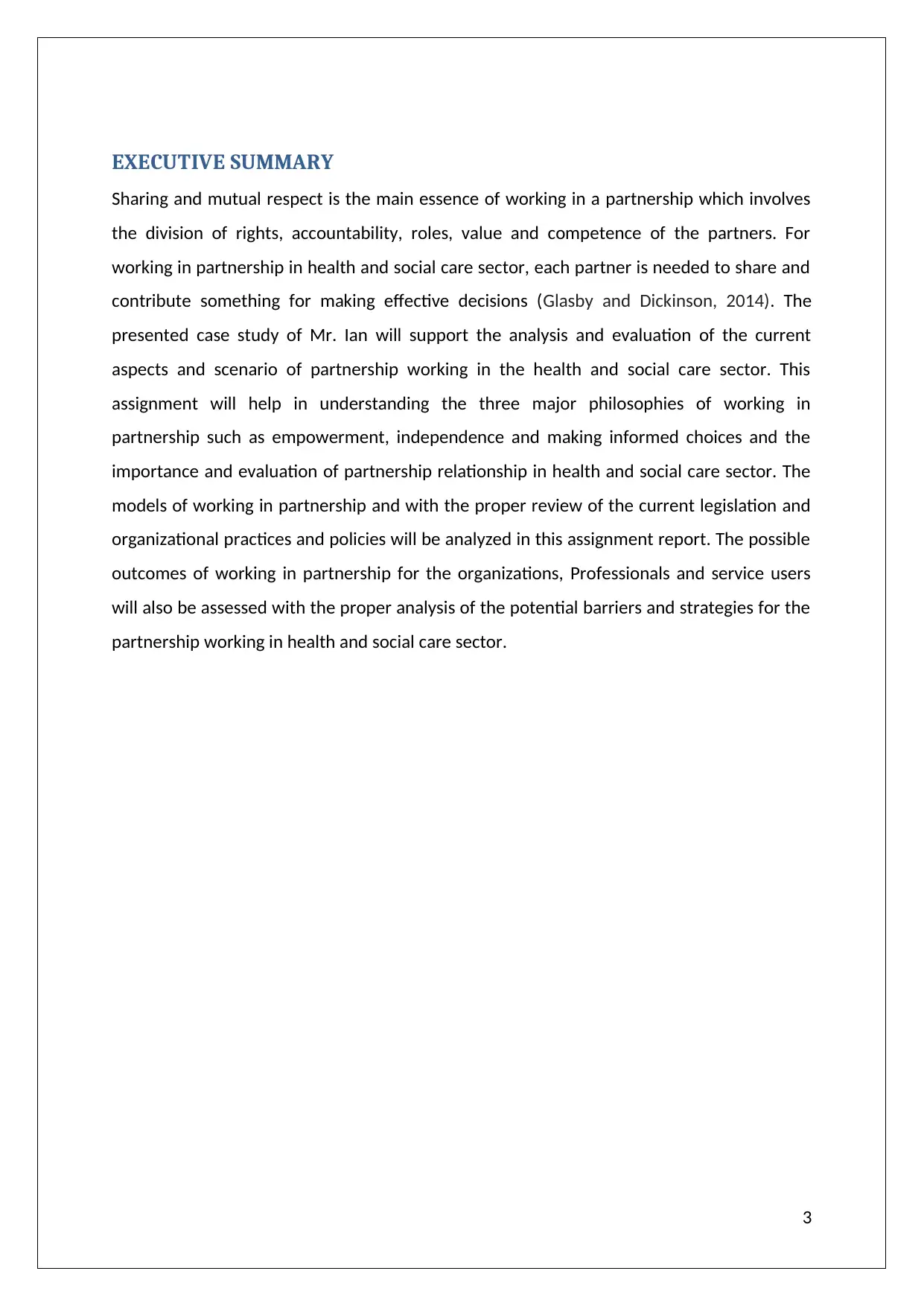
EXECUTIVE SUMMARY
Sharing and mutual respect is the main essence of working in a partnership which involves
the division of rights, accountability, roles, value and competence of the partners. For
working in partnership in health and social care sector, each partner is needed to share and
contribute something for making effective decisions (Glasby and Dickinson, 2014). The
presented case study of Mr. Ian will support the analysis and evaluation of the current
aspects and scenario of partnership working in the health and social care sector. This
assignment will help in understanding the three major philosophies of working in
partnership such as empowerment, independence and making informed choices and the
importance and evaluation of partnership relationship in health and social care sector. The
models of working in partnership and with the proper review of the current legislation and
organizational practices and policies will be analyzed in this assignment report. The possible
outcomes of working in partnership for the organizations, Professionals and service users
will also be assessed with the proper analysis of the potential barriers and strategies for the
partnership working in health and social care sector.
3
Sharing and mutual respect is the main essence of working in a partnership which involves
the division of rights, accountability, roles, value and competence of the partners. For
working in partnership in health and social care sector, each partner is needed to share and
contribute something for making effective decisions (Glasby and Dickinson, 2014). The
presented case study of Mr. Ian will support the analysis and evaluation of the current
aspects and scenario of partnership working in the health and social care sector. This
assignment will help in understanding the three major philosophies of working in
partnership such as empowerment, independence and making informed choices and the
importance and evaluation of partnership relationship in health and social care sector. The
models of working in partnership and with the proper review of the current legislation and
organizational practices and policies will be analyzed in this assignment report. The possible
outcomes of working in partnership for the organizations, Professionals and service users
will also be assessed with the proper analysis of the potential barriers and strategies for the
partnership working in health and social care sector.
3
Secure Best Marks with AI Grader
Need help grading? Try our AI Grader for instant feedback on your assignments.

SECTION A
1.1 THE PHILOSOPHIES OF WORKING IN PARTNERSHIP IN HEALTH AND
SOCIAL CARE
In the last few years, the working in partnership has been the central focus of several
organizations, institutions and government agencies in the health and social care sector.
There have been several philosophies are formed for facilitating the working in partnership
with the health and social care sector (Glasby, 2017). These philosophies and principles
serve as the basis for the creation of a partnership in the health and social care sector.
The major philosophies of the partnership working are power-sharing, trust, autonomy,
empowerment, respect, independence and making an informed choice. The three of the
most essential philosophies are discussed below.
EMPOWERMENT: This philosophy lays emphasis on the concept of empowerment.
The organizations involved in the partnership need to be capable of empowering
each other through the adequate and effective coordination of the process and
activities for increasing the abilities of the partner organizations in achieving the
targeted goals and objectives (Glasby, 2017). In the case of Mr. Ian, there was the
absence of empowerment among the professionals and organizations and Mr. Ian
himself did not cooperate with their care providers.
INDEPENDENCE: the philosophy of independence is originated for limiting the
interdependence of the organizations in the health and social care partnership. It
suggests that although partner organizations may depend on each other there must
be certain limitations to enable the organization to stand on its own for fulfilling its
respective responsibilities. For example, in order to care a drug addict person, the
Rehabilitation Centre and a psychologist are providing care to the person in
partnership but in the absence of psychologist, the rehabilitation services need to
continue its responsibilities and vice versa (Määttä et al., 2017).
The organizations serving Mr. Ian has become largely interdependent on each other
and could not perform their roles and responsibilities this causes neglected health
and condition of Mr. Ian and failure in the services.
4
1.1 THE PHILOSOPHIES OF WORKING IN PARTNERSHIP IN HEALTH AND
SOCIAL CARE
In the last few years, the working in partnership has been the central focus of several
organizations, institutions and government agencies in the health and social care sector.
There have been several philosophies are formed for facilitating the working in partnership
with the health and social care sector (Glasby, 2017). These philosophies and principles
serve as the basis for the creation of a partnership in the health and social care sector.
The major philosophies of the partnership working are power-sharing, trust, autonomy,
empowerment, respect, independence and making an informed choice. The three of the
most essential philosophies are discussed below.
EMPOWERMENT: This philosophy lays emphasis on the concept of empowerment.
The organizations involved in the partnership need to be capable of empowering
each other through the adequate and effective coordination of the process and
activities for increasing the abilities of the partner organizations in achieving the
targeted goals and objectives (Glasby, 2017). In the case of Mr. Ian, there was the
absence of empowerment among the professionals and organizations and Mr. Ian
himself did not cooperate with their care providers.
INDEPENDENCE: the philosophy of independence is originated for limiting the
interdependence of the organizations in the health and social care partnership. It
suggests that although partner organizations may depend on each other there must
be certain limitations to enable the organization to stand on its own for fulfilling its
respective responsibilities. For example, in order to care a drug addict person, the
Rehabilitation Centre and a psychologist are providing care to the person in
partnership but in the absence of psychologist, the rehabilitation services need to
continue its responsibilities and vice versa (Määttä et al., 2017).
The organizations serving Mr. Ian has become largely interdependent on each other
and could not perform their roles and responsibilities this causes neglected health
and condition of Mr. Ian and failure in the services.
4

MAKING INFORMED CHOICES: The organizations in a partnership must share the
relevant information and decisions with each other for benefitting themselves and
the customers as well. For example, the organizations responsible for supplying
medicines and drugs to the health care centre must be primarily informed about the
need and shortage of supplies by the health care centre to ensure sufficient
availability of pharmaceutical products to maintain the flow of services (Fotaki,
2011).
The reduced involvement of OT and CSW during Mr. Ian admitted to the hospital
due to urinary tract infection has caused problems to the doctor in completing the
risk assessment and other paperwork because of incomplete information. During the
significant changes in the case an issue regarding the responsible team was unclear
and causes confusion, pressure and frustration among the partnership.
5
relevant information and decisions with each other for benefitting themselves and
the customers as well. For example, the organizations responsible for supplying
medicines and drugs to the health care centre must be primarily informed about the
need and shortage of supplies by the health care centre to ensure sufficient
availability of pharmaceutical products to maintain the flow of services (Fotaki,
2011).
The reduced involvement of OT and CSW during Mr. Ian admitted to the hospital
due to urinary tract infection has caused problems to the doctor in completing the
risk assessment and other paperwork because of incomplete information. During the
significant changes in the case an issue regarding the responsible team was unclear
and causes confusion, pressure and frustration among the partnership.
5

1.2 EVALUATION OF PARTNERSHIP RELATIONSHIP WITHIN HEALTH AND
SOCIAL CARE SERVICES
LEVELS OF PARTNERSHIP WORKING IN THE CASE OF MR. IAN
By evaluating the case study of Mr. Ian it is founded that the partnership relationship in the
health and social care industry is not been very effective or strong. This case consists of
levels of partnership which are not proved effective due to several reasons. On this regards,
the partnership relationship in case of Mr. Ian will be evaluated on the basis of three levels:
Service User Level: At this level, the partnership relationship among the service providers
and service taker is being evaluated. The relationship of service taker MR. Ian with the
several service-providing professionals and organizations such as staff of Local Authority
Long Term Team (LATT), Mental Health Review and Reablement (R&R), Risk Enablement
Panel (REP), occupational therapist, community support workers (CSW) and other
institutions and family is not been effectively developed due to the behavior of Mr. Ian. Due
to his alcohol consumption habits and aggressive nature the service providing team was
unable to provide quality services to him (Reeves et al., 2011).
Professional Level: this level involves the evaluation of the partnership relationship at the
professional level among the occupational therapist and other care individual service
providers (Glasby, J., 2017) of Mr. Ian. The doctors, therapist and the staff of the
organizations were unable to provide better services to Mr. Ian as they felt a much higher
risk of harm to others by him and they could not effectively share information and hence,
failed to provide services to Mr. Ian.
Organizational Level: this level involves the evaluation of the relationship between the
several organizations (Glasby, J., 2017). It is founded all of these organizations could not
effectively make the strategies and service requirements of Mr. Ian and neglected him by
transferring their responsibilities on each other in absence of cooperation and proper
collaboration among them.
WHITE PAPERS AND LEGISLATION THAT SUPPORTS COLLABORATIVE WORKING
6
SOCIAL CARE SERVICES
LEVELS OF PARTNERSHIP WORKING IN THE CASE OF MR. IAN
By evaluating the case study of Mr. Ian it is founded that the partnership relationship in the
health and social care industry is not been very effective or strong. This case consists of
levels of partnership which are not proved effective due to several reasons. On this regards,
the partnership relationship in case of Mr. Ian will be evaluated on the basis of three levels:
Service User Level: At this level, the partnership relationship among the service providers
and service taker is being evaluated. The relationship of service taker MR. Ian with the
several service-providing professionals and organizations such as staff of Local Authority
Long Term Team (LATT), Mental Health Review and Reablement (R&R), Risk Enablement
Panel (REP), occupational therapist, community support workers (CSW) and other
institutions and family is not been effectively developed due to the behavior of Mr. Ian. Due
to his alcohol consumption habits and aggressive nature the service providing team was
unable to provide quality services to him (Reeves et al., 2011).
Professional Level: this level involves the evaluation of the partnership relationship at the
professional level among the occupational therapist and other care individual service
providers (Glasby, J., 2017) of Mr. Ian. The doctors, therapist and the staff of the
organizations were unable to provide better services to Mr. Ian as they felt a much higher
risk of harm to others by him and they could not effectively share information and hence,
failed to provide services to Mr. Ian.
Organizational Level: this level involves the evaluation of the relationship between the
several organizations (Glasby, J., 2017). It is founded all of these organizations could not
effectively make the strategies and service requirements of Mr. Ian and neglected him by
transferring their responsibilities on each other in absence of cooperation and proper
collaboration among them.
WHITE PAPERS AND LEGISLATION THAT SUPPORTS COLLABORATIVE WORKING
6
Paraphrase This Document
Need a fresh take? Get an instant paraphrase of this document with our AI Paraphraser
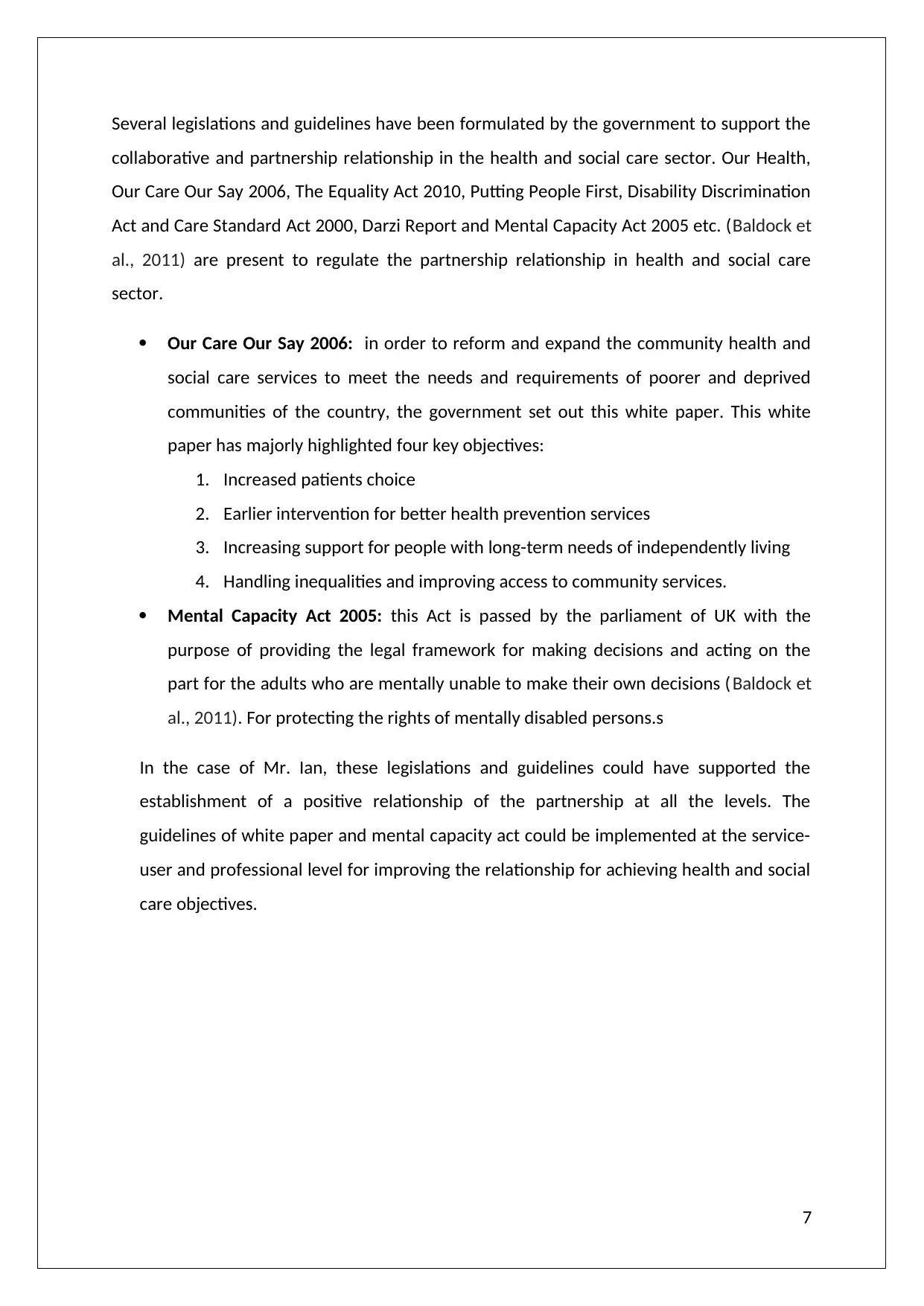
Several legislations and guidelines have been formulated by the government to support the
collaborative and partnership relationship in the health and social care sector. Our Health,
Our Care Our Say 2006, The Equality Act 2010, Putting People First, Disability Discrimination
Act and Care Standard Act 2000, Darzi Report and Mental Capacity Act 2005 etc. (Baldock et
al., 2011) are present to regulate the partnership relationship in health and social care
sector.
Our Care Our Say 2006: in order to reform and expand the community health and
social care services to meet the needs and requirements of poorer and deprived
communities of the country, the government set out this white paper. This white
paper has majorly highlighted four key objectives:
1. Increased patients choice
2. Earlier intervention for better health prevention services
3. Increasing support for people with long-term needs of independently living
4. Handling inequalities and improving access to community services.
Mental Capacity Act 2005: this Act is passed by the parliament of UK with the
purpose of providing the legal framework for making decisions and acting on the
part for the adults who are mentally unable to make their own decisions (Baldock et
al., 2011). For protecting the rights of mentally disabled persons.s
In the case of Mr. Ian, these legislations and guidelines could have supported the
establishment of a positive relationship of the partnership at all the levels. The
guidelines of white paper and mental capacity act could be implemented at the service-
user and professional level for improving the relationship for achieving health and social
care objectives.
7
collaborative and partnership relationship in the health and social care sector. Our Health,
Our Care Our Say 2006, The Equality Act 2010, Putting People First, Disability Discrimination
Act and Care Standard Act 2000, Darzi Report and Mental Capacity Act 2005 etc. (Baldock et
al., 2011) are present to regulate the partnership relationship in health and social care
sector.
Our Care Our Say 2006: in order to reform and expand the community health and
social care services to meet the needs and requirements of poorer and deprived
communities of the country, the government set out this white paper. This white
paper has majorly highlighted four key objectives:
1. Increased patients choice
2. Earlier intervention for better health prevention services
3. Increasing support for people with long-term needs of independently living
4. Handling inequalities and improving access to community services.
Mental Capacity Act 2005: this Act is passed by the parliament of UK with the
purpose of providing the legal framework for making decisions and acting on the
part for the adults who are mentally unable to make their own decisions (Baldock et
al., 2011). For protecting the rights of mentally disabled persons.s
In the case of Mr. Ian, these legislations and guidelines could have supported the
establishment of a positive relationship of the partnership at all the levels. The
guidelines of white paper and mental capacity act could be implemented at the service-
user and professional level for improving the relationship for achieving health and social
care objectives.
7
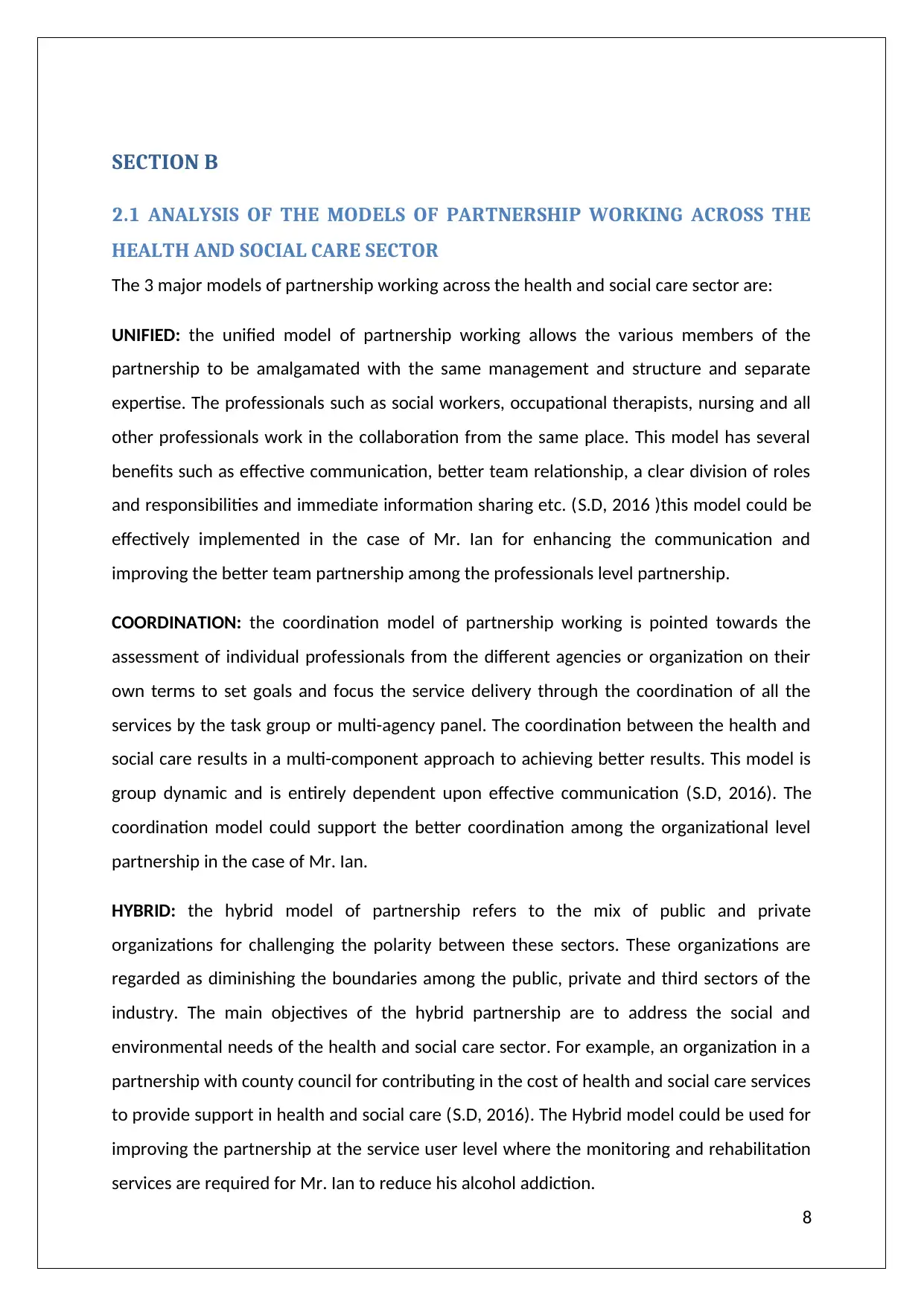
SECTION B
2.1 ANALYSIS OF THE MODELS OF PARTNERSHIP WORKING ACROSS THE
HEALTH AND SOCIAL CARE SECTOR
The 3 major models of partnership working across the health and social care sector are:
UNIFIED: the unified model of partnership working allows the various members of the
partnership to be amalgamated with the same management and structure and separate
expertise. The professionals such as social workers, occupational therapists, nursing and all
other professionals work in the collaboration from the same place. This model has several
benefits such as effective communication, better team relationship, a clear division of roles
and responsibilities and immediate information sharing etc. (S.D, 2016 )this model could be
effectively implemented in the case of Mr. Ian for enhancing the communication and
improving the better team partnership among the professionals level partnership.
COORDINATION: the coordination model of partnership working is pointed towards the
assessment of individual professionals from the different agencies or organization on their
own terms to set goals and focus the service delivery through the coordination of all the
services by the task group or multi-agency panel. The coordination between the health and
social care results in a multi-component approach to achieving better results. This model is
group dynamic and is entirely dependent upon effective communication (S.D, 2016). The
coordination model could support the better coordination among the organizational level
partnership in the case of Mr. Ian.
HYBRID: the hybrid model of partnership refers to the mix of public and private
organizations for challenging the polarity between these sectors. These organizations are
regarded as diminishing the boundaries among the public, private and third sectors of the
industry. The main objectives of the hybrid partnership are to address the social and
environmental needs of the health and social care sector. For example, an organization in a
partnership with county council for contributing in the cost of health and social care services
to provide support in health and social care (S.D, 2016). The Hybrid model could be used for
improving the partnership at the service user level where the monitoring and rehabilitation
services are required for Mr. Ian to reduce his alcohol addiction.
8
2.1 ANALYSIS OF THE MODELS OF PARTNERSHIP WORKING ACROSS THE
HEALTH AND SOCIAL CARE SECTOR
The 3 major models of partnership working across the health and social care sector are:
UNIFIED: the unified model of partnership working allows the various members of the
partnership to be amalgamated with the same management and structure and separate
expertise. The professionals such as social workers, occupational therapists, nursing and all
other professionals work in the collaboration from the same place. This model has several
benefits such as effective communication, better team relationship, a clear division of roles
and responsibilities and immediate information sharing etc. (S.D, 2016 )this model could be
effectively implemented in the case of Mr. Ian for enhancing the communication and
improving the better team partnership among the professionals level partnership.
COORDINATION: the coordination model of partnership working is pointed towards the
assessment of individual professionals from the different agencies or organization on their
own terms to set goals and focus the service delivery through the coordination of all the
services by the task group or multi-agency panel. The coordination between the health and
social care results in a multi-component approach to achieving better results. This model is
group dynamic and is entirely dependent upon effective communication (S.D, 2016). The
coordination model could support the better coordination among the organizational level
partnership in the case of Mr. Ian.
HYBRID: the hybrid model of partnership refers to the mix of public and private
organizations for challenging the polarity between these sectors. These organizations are
regarded as diminishing the boundaries among the public, private and third sectors of the
industry. The main objectives of the hybrid partnership are to address the social and
environmental needs of the health and social care sector. For example, an organization in a
partnership with county council for contributing in the cost of health and social care services
to provide support in health and social care (S.D, 2016). The Hybrid model could be used for
improving the partnership at the service user level where the monitoring and rehabilitation
services are required for Mr. Ian to reduce his alcohol addiction.
8
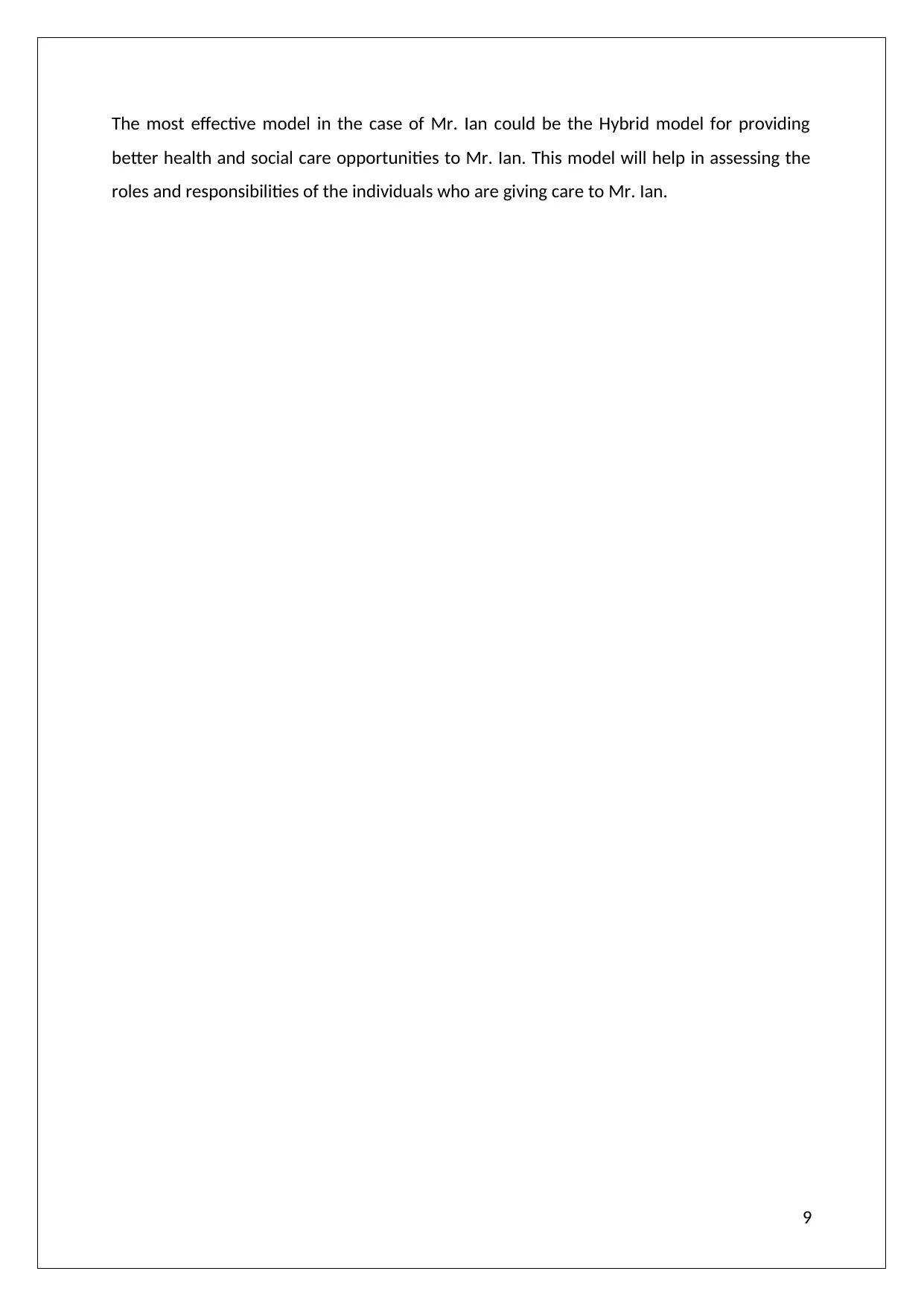
The most effective model in the case of Mr. Ian could be the Hybrid model for providing
better health and social care opportunities to Mr. Ian. This model will help in assessing the
roles and responsibilities of the individuals who are giving care to Mr. Ian.
9
better health and social care opportunities to Mr. Ian. This model will help in assessing the
roles and responsibilities of the individuals who are giving care to Mr. Ian.
9
Secure Best Marks with AI Grader
Need help grading? Try our AI Grader for instant feedback on your assignments.
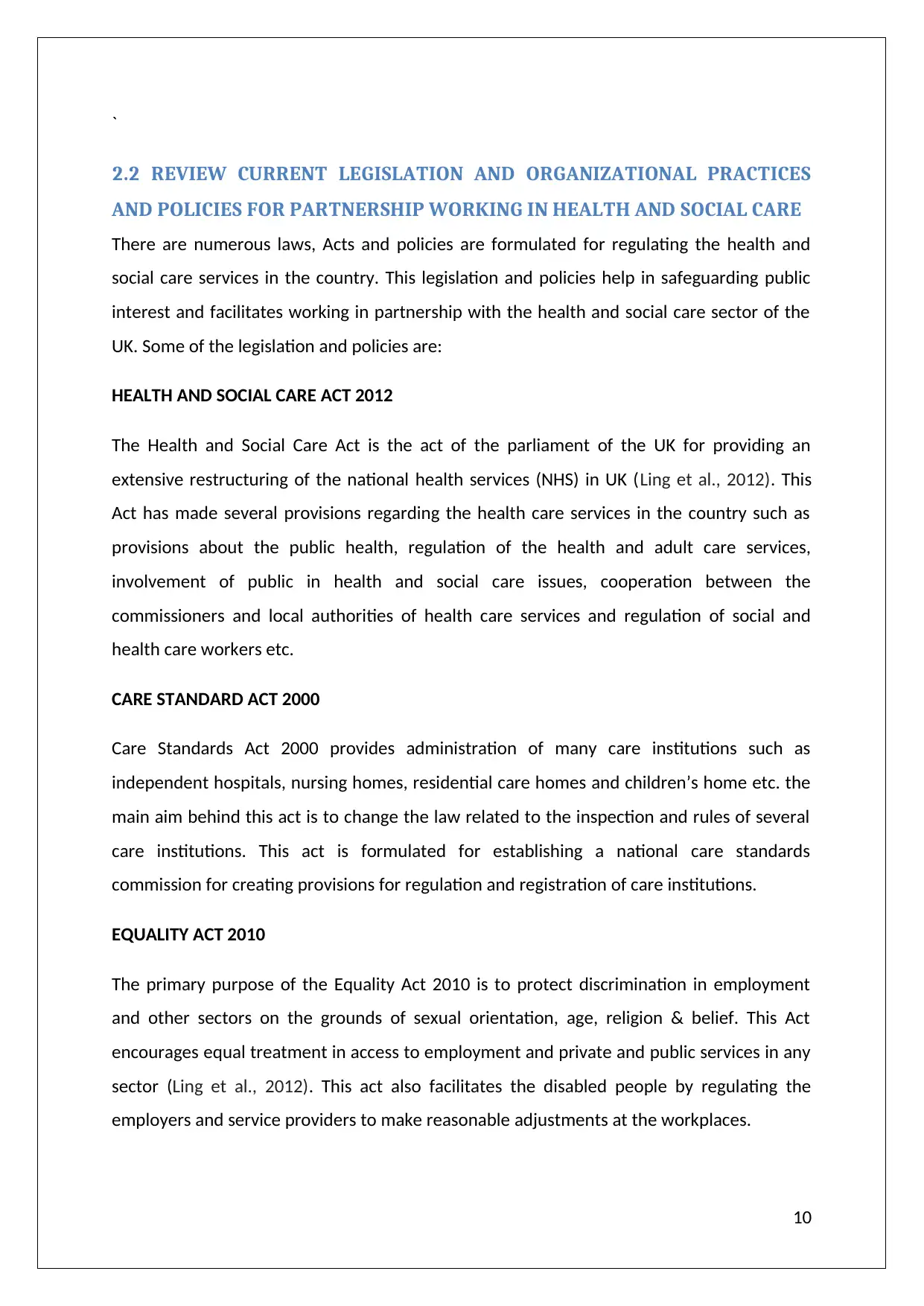
`
2.2 REVIEW CURRENT LEGISLATION AND ORGANIZATIONAL PRACTICES
AND POLICIES FOR PARTNERSHIP WORKING IN HEALTH AND SOCIAL CARE
There are numerous laws, Acts and policies are formulated for regulating the health and
social care services in the country. This legislation and policies help in safeguarding public
interest and facilitates working in partnership with the health and social care sector of the
UK. Some of the legislation and policies are:
HEALTH AND SOCIAL CARE ACT 2012
The Health and Social Care Act is the act of the parliament of the UK for providing an
extensive restructuring of the national health services (NHS) in UK (Ling et al., 2012). This
Act has made several provisions regarding the health care services in the country such as
provisions about the public health, regulation of the health and adult care services,
involvement of public in health and social care issues, cooperation between the
commissioners and local authorities of health care services and regulation of social and
health care workers etc.
CARE STANDARD ACT 2000
Care Standards Act 2000 provides administration of many care institutions such as
independent hospitals, nursing homes, residential care homes and children’s home etc. the
main aim behind this act is to change the law related to the inspection and rules of several
care institutions. This act is formulated for establishing a national care standards
commission for creating provisions for regulation and registration of care institutions.
EQUALITY ACT 2010
The primary purpose of the Equality Act 2010 is to protect discrimination in employment
and other sectors on the grounds of sexual orientation, age, religion & belief. This Act
encourages equal treatment in access to employment and private and public services in any
sector (Ling et al., 2012). This act also facilitates the disabled people by regulating the
employers and service providers to make reasonable adjustments at the workplaces.
10
2.2 REVIEW CURRENT LEGISLATION AND ORGANIZATIONAL PRACTICES
AND POLICIES FOR PARTNERSHIP WORKING IN HEALTH AND SOCIAL CARE
There are numerous laws, Acts and policies are formulated for regulating the health and
social care services in the country. This legislation and policies help in safeguarding public
interest and facilitates working in partnership with the health and social care sector of the
UK. Some of the legislation and policies are:
HEALTH AND SOCIAL CARE ACT 2012
The Health and Social Care Act is the act of the parliament of the UK for providing an
extensive restructuring of the national health services (NHS) in UK (Ling et al., 2012). This
Act has made several provisions regarding the health care services in the country such as
provisions about the public health, regulation of the health and adult care services,
involvement of public in health and social care issues, cooperation between the
commissioners and local authorities of health care services and regulation of social and
health care workers etc.
CARE STANDARD ACT 2000
Care Standards Act 2000 provides administration of many care institutions such as
independent hospitals, nursing homes, residential care homes and children’s home etc. the
main aim behind this act is to change the law related to the inspection and rules of several
care institutions. This act is formulated for establishing a national care standards
commission for creating provisions for regulation and registration of care institutions.
EQUALITY ACT 2010
The primary purpose of the Equality Act 2010 is to protect discrimination in employment
and other sectors on the grounds of sexual orientation, age, religion & belief. This Act
encourages equal treatment in access to employment and private and public services in any
sector (Ling et al., 2012). This act also facilitates the disabled people by regulating the
employers and service providers to make reasonable adjustments at the workplaces.
10
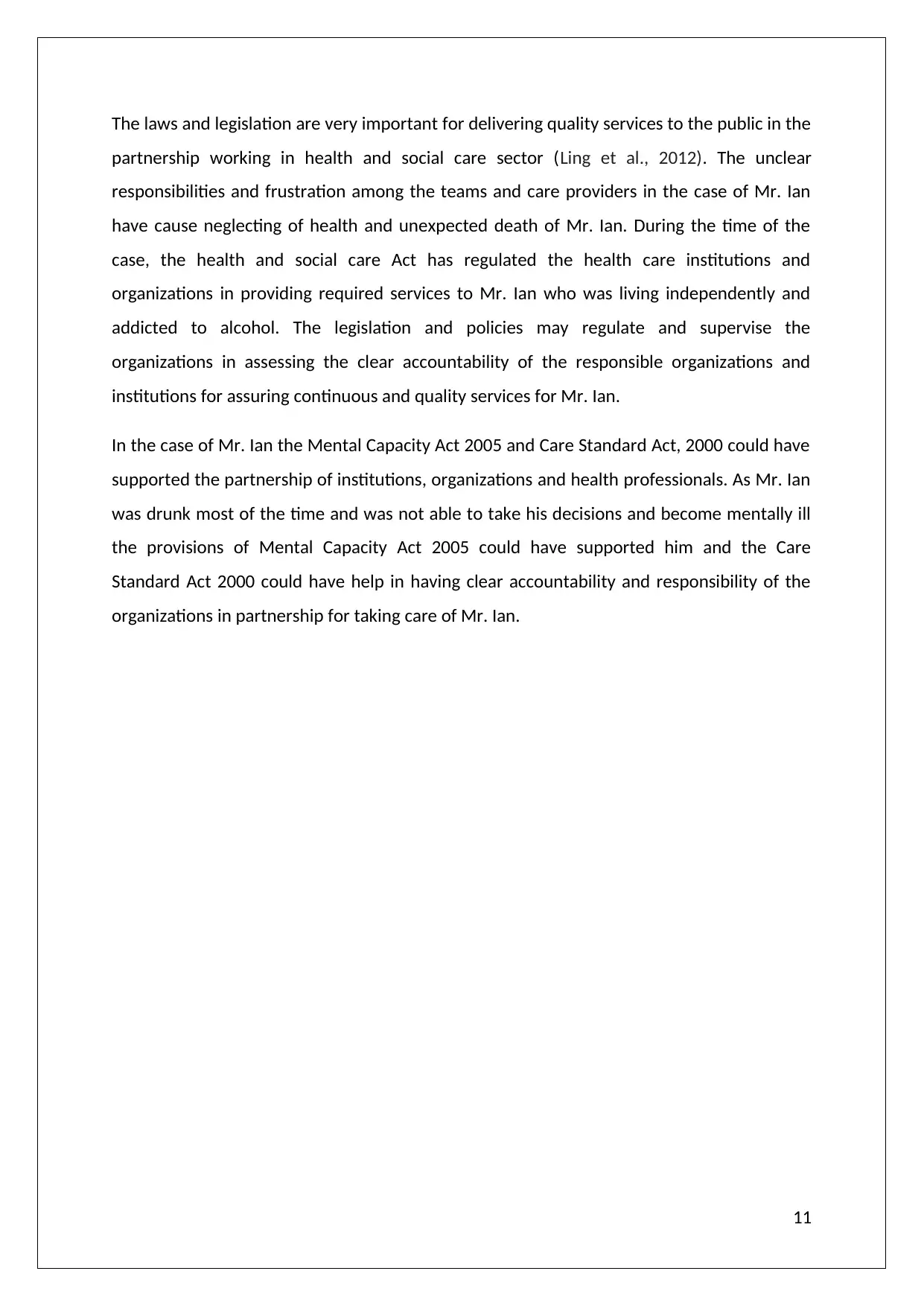
The laws and legislation are very important for delivering quality services to the public in the
partnership working in health and social care sector (Ling et al., 2012). The unclear
responsibilities and frustration among the teams and care providers in the case of Mr. Ian
have cause neglecting of health and unexpected death of Mr. Ian. During the time of the
case, the health and social care Act has regulated the health care institutions and
organizations in providing required services to Mr. Ian who was living independently and
addicted to alcohol. The legislation and policies may regulate and supervise the
organizations in assessing the clear accountability of the responsible organizations and
institutions for assuring continuous and quality services for Mr. Ian.
In the case of Mr. Ian the Mental Capacity Act 2005 and Care Standard Act, 2000 could have
supported the partnership of institutions, organizations and health professionals. As Mr. Ian
was drunk most of the time and was not able to take his decisions and become mentally ill
the provisions of Mental Capacity Act 2005 could have supported him and the Care
Standard Act 2000 could have help in having clear accountability and responsibility of the
organizations in partnership for taking care of Mr. Ian.
11
partnership working in health and social care sector (Ling et al., 2012). The unclear
responsibilities and frustration among the teams and care providers in the case of Mr. Ian
have cause neglecting of health and unexpected death of Mr. Ian. During the time of the
case, the health and social care Act has regulated the health care institutions and
organizations in providing required services to Mr. Ian who was living independently and
addicted to alcohol. The legislation and policies may regulate and supervise the
organizations in assessing the clear accountability of the responsible organizations and
institutions for assuring continuous and quality services for Mr. Ian.
In the case of Mr. Ian the Mental Capacity Act 2005 and Care Standard Act, 2000 could have
supported the partnership of institutions, organizations and health professionals. As Mr. Ian
was drunk most of the time and was not able to take his decisions and become mentally ill
the provisions of Mental Capacity Act 2005 could have supported him and the Care
Standard Act 2000 could have help in having clear accountability and responsibility of the
organizations in partnership for taking care of Mr. Ian.
11
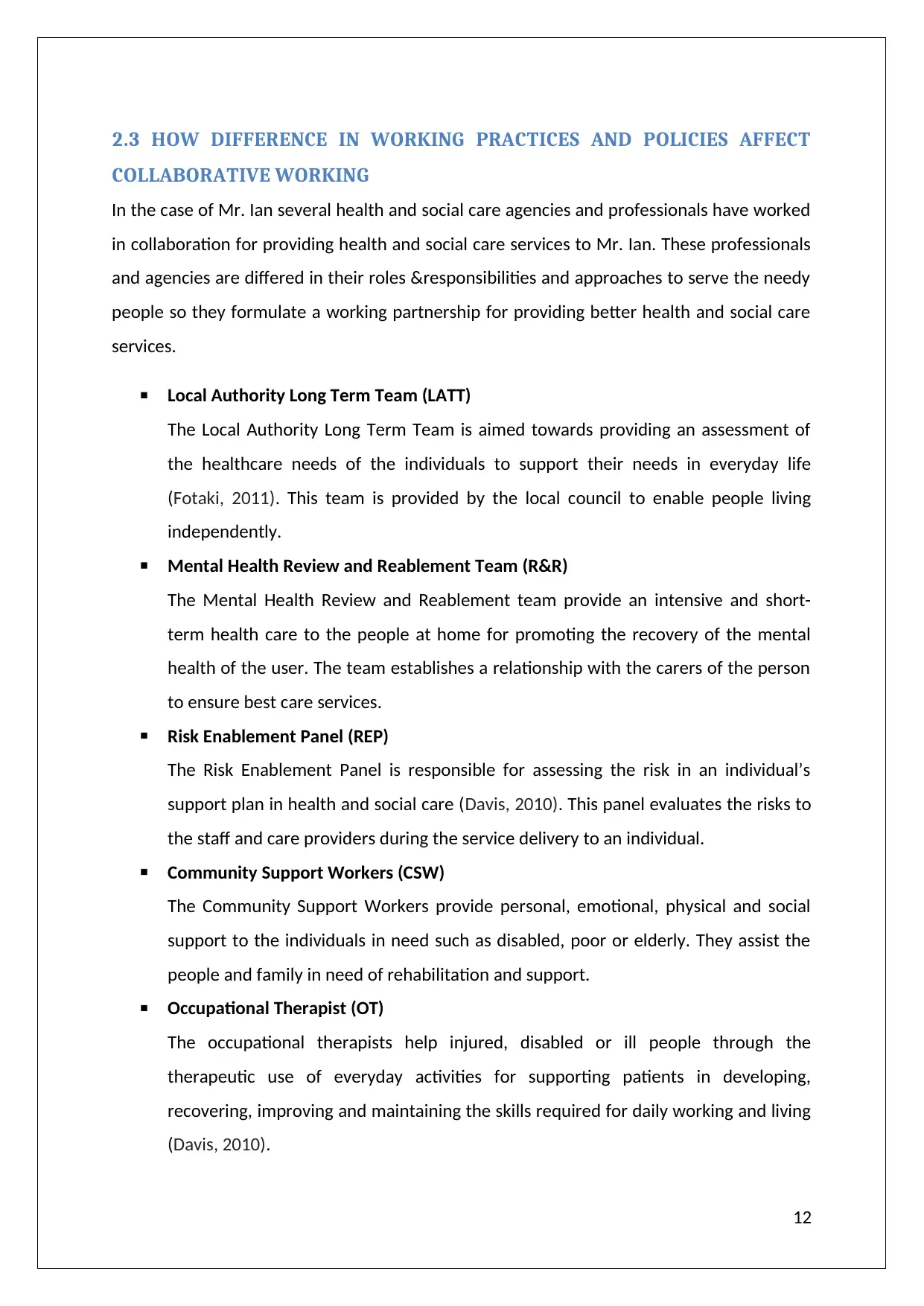
2.3 HOW DIFFERENCE IN WORKING PRACTICES AND POLICIES AFFECT
COLLABORATIVE WORKING
In the case of Mr. Ian several health and social care agencies and professionals have worked
in collaboration for providing health and social care services to Mr. Ian. These professionals
and agencies are differed in their roles &responsibilities and approaches to serve the needy
people so they formulate a working partnership for providing better health and social care
services.
Local Authority Long Term Team (LATT)
The Local Authority Long Term Team is aimed towards providing an assessment of
the healthcare needs of the individuals to support their needs in everyday life
(Fotaki, 2011). This team is provided by the local council to enable people living
independently.
Mental Health Review and Reablement Team (R&R)
The Mental Health Review and Reablement team provide an intensive and short-
term health care to the people at home for promoting the recovery of the mental
health of the user. The team establishes a relationship with the carers of the person
to ensure best care services.
Risk Enablement Panel (REP)
The Risk Enablement Panel is responsible for assessing the risk in an individual’s
support plan in health and social care (Davis, 2010). This panel evaluates the risks to
the staff and care providers during the service delivery to an individual.
Community Support Workers (CSW)
The Community Support Workers provide personal, emotional, physical and social
support to the individuals in need such as disabled, poor or elderly. They assist the
people and family in need of rehabilitation and support.
Occupational Therapist (OT)
The occupational therapists help injured, disabled or ill people through the
therapeutic use of everyday activities for supporting patients in developing,
recovering, improving and maintaining the skills required for daily working and living
(Davis, 2010).
12
COLLABORATIVE WORKING
In the case of Mr. Ian several health and social care agencies and professionals have worked
in collaboration for providing health and social care services to Mr. Ian. These professionals
and agencies are differed in their roles &responsibilities and approaches to serve the needy
people so they formulate a working partnership for providing better health and social care
services.
Local Authority Long Term Team (LATT)
The Local Authority Long Term Team is aimed towards providing an assessment of
the healthcare needs of the individuals to support their needs in everyday life
(Fotaki, 2011). This team is provided by the local council to enable people living
independently.
Mental Health Review and Reablement Team (R&R)
The Mental Health Review and Reablement team provide an intensive and short-
term health care to the people at home for promoting the recovery of the mental
health of the user. The team establishes a relationship with the carers of the person
to ensure best care services.
Risk Enablement Panel (REP)
The Risk Enablement Panel is responsible for assessing the risk in an individual’s
support plan in health and social care (Davis, 2010). This panel evaluates the risks to
the staff and care providers during the service delivery to an individual.
Community Support Workers (CSW)
The Community Support Workers provide personal, emotional, physical and social
support to the individuals in need such as disabled, poor or elderly. They assist the
people and family in need of rehabilitation and support.
Occupational Therapist (OT)
The occupational therapists help injured, disabled or ill people through the
therapeutic use of everyday activities for supporting patients in developing,
recovering, improving and maintaining the skills required for daily working and living
(Davis, 2010).
12
Paraphrase This Document
Need a fresh take? Get an instant paraphrase of this document with our AI Paraphraser
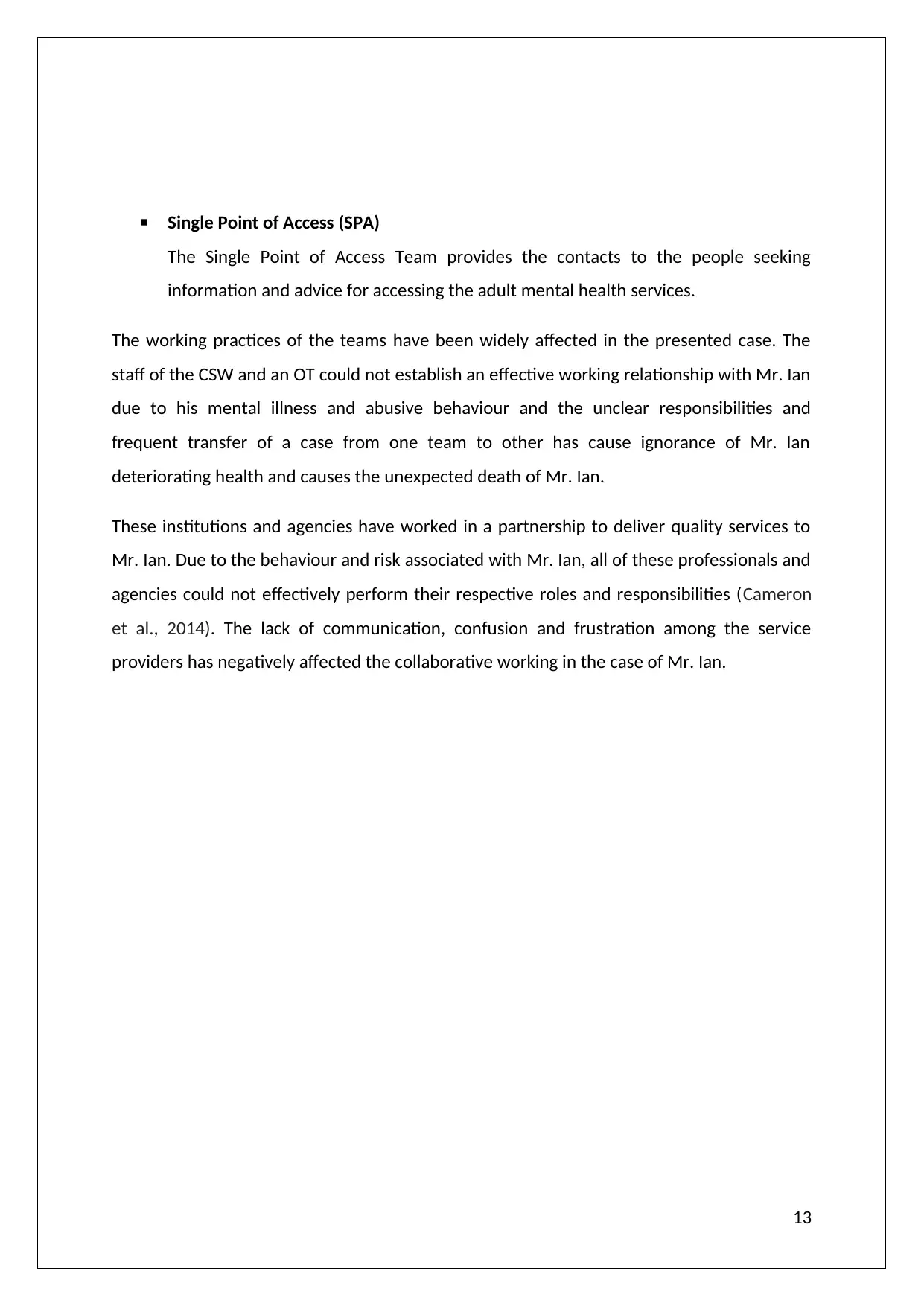
Single Point of Access (SPA)
The Single Point of Access Team provides the contacts to the people seeking
information and advice for accessing the adult mental health services.
The working practices of the teams have been widely affected in the presented case. The
staff of the CSW and an OT could not establish an effective working relationship with Mr. Ian
due to his mental illness and abusive behaviour and the unclear responsibilities and
frequent transfer of a case from one team to other has cause ignorance of Mr. Ian
deteriorating health and causes the unexpected death of Mr. Ian.
These institutions and agencies have worked in a partnership to deliver quality services to
Mr. Ian. Due to the behaviour and risk associated with Mr. Ian, all of these professionals and
agencies could not effectively perform their respective roles and responsibilities (Cameron
et al., 2014). The lack of communication, confusion and frustration among the service
providers has negatively affected the collaborative working in the case of Mr. Ian.
13
The Single Point of Access Team provides the contacts to the people seeking
information and advice for accessing the adult mental health services.
The working practices of the teams have been widely affected in the presented case. The
staff of the CSW and an OT could not establish an effective working relationship with Mr. Ian
due to his mental illness and abusive behaviour and the unclear responsibilities and
frequent transfer of a case from one team to other has cause ignorance of Mr. Ian
deteriorating health and causes the unexpected death of Mr. Ian.
These institutions and agencies have worked in a partnership to deliver quality services to
Mr. Ian. Due to the behaviour and risk associated with Mr. Ian, all of these professionals and
agencies could not effectively perform their respective roles and responsibilities (Cameron
et al., 2014). The lack of communication, confusion and frustration among the service
providers has negatively affected the collaborative working in the case of Mr. Ian.
13

SECTION C
3.1 THE POSSIBLE OUTCOMES OF PARTNERSHIP WORKING FOR USERS OF
SERVICES, PROFESSIONALS AND ORGANISATION
In ever partnership working the outcomes may be positive or negative at every level of
partnership. These outcomes are occurred due to the actions of the service users,
organizations and professionals during the health and social care practices (Reeves et al.,
2011). In the case of Mr. Ian the possible outcomes at the different levels are:
SERVICE USER OUTCOME
The positive and negative outcomes at the service user level are discussed below:
Positive Outcomes Are:
Empowerment- the relationship between Mr. Ian and the staff members and
professionals of the organization help in empowering the lives of Mr. Ian.
Autonomy- the professionals in working partnership are independent in making their
own decisions.
Negative Outcomes Are:
Neglect- unclear responsibilities in partnership have causes the neglecting of the
health of Mr. Ian.
Abuse- the aggressive and abusive behaviour of Mr. Ian has affected the services
negatively (Tambuyzer et al., 2014).
Miscommunication- due to the alcohol addiction of Mr. Ian the communication
between the service provider and a user has been badly affected.
Confusion- there is a presence of confusion among the service providers and users
during working in partnership at the service user level.
PROFESSIONAL OUTCOME
The possible outcomes and its impact on the professional level are discussed below:
Positive Outcomes Are:
14
3.1 THE POSSIBLE OUTCOMES OF PARTNERSHIP WORKING FOR USERS OF
SERVICES, PROFESSIONALS AND ORGANISATION
In ever partnership working the outcomes may be positive or negative at every level of
partnership. These outcomes are occurred due to the actions of the service users,
organizations and professionals during the health and social care practices (Reeves et al.,
2011). In the case of Mr. Ian the possible outcomes at the different levels are:
SERVICE USER OUTCOME
The positive and negative outcomes at the service user level are discussed below:
Positive Outcomes Are:
Empowerment- the relationship between Mr. Ian and the staff members and
professionals of the organization help in empowering the lives of Mr. Ian.
Autonomy- the professionals in working partnership are independent in making their
own decisions.
Negative Outcomes Are:
Neglect- unclear responsibilities in partnership have causes the neglecting of the
health of Mr. Ian.
Abuse- the aggressive and abusive behaviour of Mr. Ian has affected the services
negatively (Tambuyzer et al., 2014).
Miscommunication- due to the alcohol addiction of Mr. Ian the communication
between the service provider and a user has been badly affected.
Confusion- there is a presence of confusion among the service providers and users
during working in partnership at the service user level.
PROFESSIONAL OUTCOME
The possible outcomes and its impact on the professional level are discussed below:
Positive Outcomes Are:
14
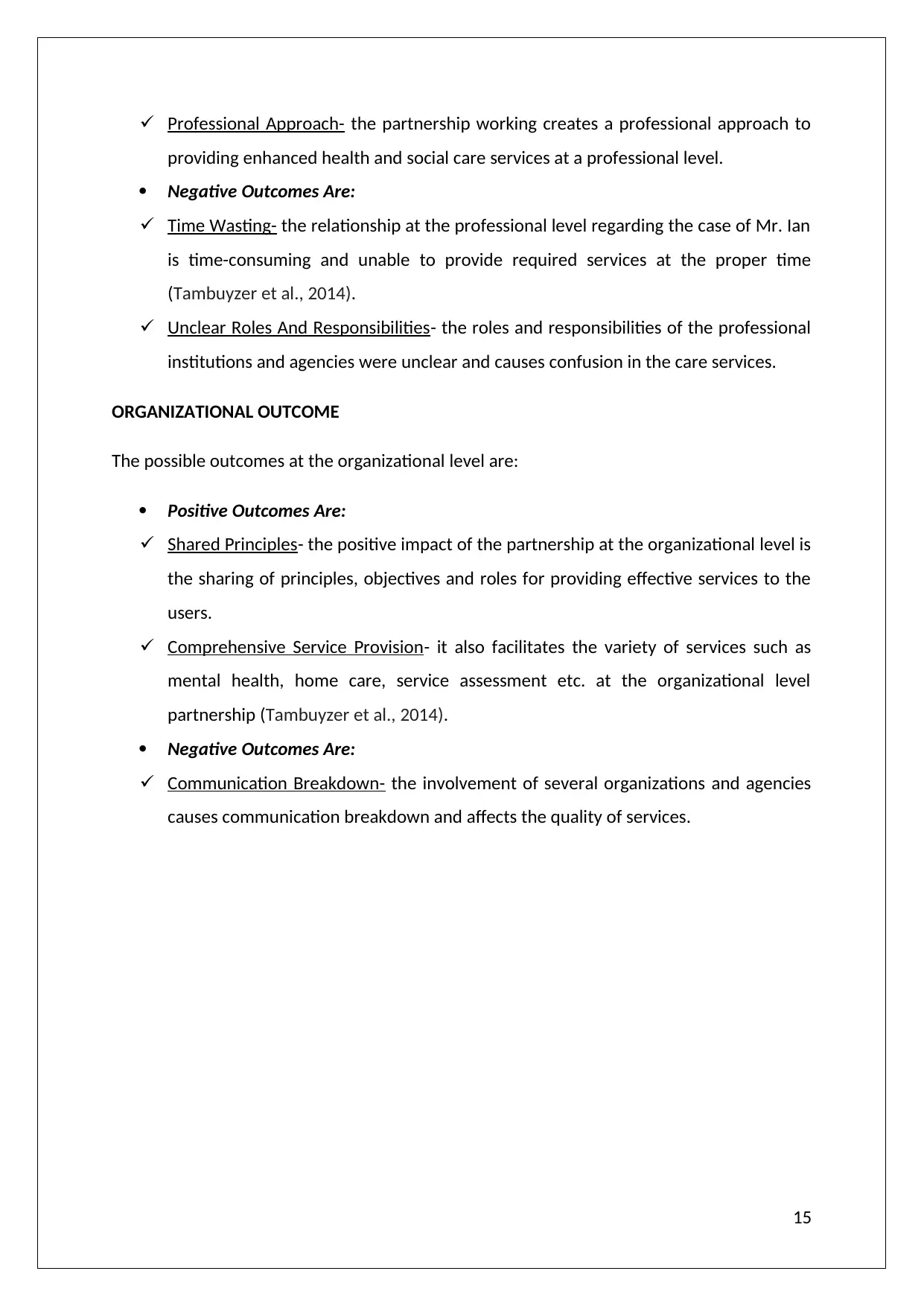
Professional Approach- the partnership working creates a professional approach to
providing enhanced health and social care services at a professional level.
Negative Outcomes Are:
Time Wasting- the relationship at the professional level regarding the case of Mr. Ian
is time-consuming and unable to provide required services at the proper time
(Tambuyzer et al., 2014).
Unclear Roles And Responsibilities- the roles and responsibilities of the professional
institutions and agencies were unclear and causes confusion in the care services.
ORGANIZATIONAL OUTCOME
The possible outcomes at the organizational level are:
Positive Outcomes Are:
Shared Principles- the positive impact of the partnership at the organizational level is
the sharing of principles, objectives and roles for providing effective services to the
users.
Comprehensive Service Provision- it also facilitates the variety of services such as
mental health, home care, service assessment etc. at the organizational level
partnership (Tambuyzer et al., 2014).
Negative Outcomes Are:
Communication Breakdown- the involvement of several organizations and agencies
causes communication breakdown and affects the quality of services.
15
providing enhanced health and social care services at a professional level.
Negative Outcomes Are:
Time Wasting- the relationship at the professional level regarding the case of Mr. Ian
is time-consuming and unable to provide required services at the proper time
(Tambuyzer et al., 2014).
Unclear Roles And Responsibilities- the roles and responsibilities of the professional
institutions and agencies were unclear and causes confusion in the care services.
ORGANIZATIONAL OUTCOME
The possible outcomes at the organizational level are:
Positive Outcomes Are:
Shared Principles- the positive impact of the partnership at the organizational level is
the sharing of principles, objectives and roles for providing effective services to the
users.
Comprehensive Service Provision- it also facilitates the variety of services such as
mental health, home care, service assessment etc. at the organizational level
partnership (Tambuyzer et al., 2014).
Negative Outcomes Are:
Communication Breakdown- the involvement of several organizations and agencies
causes communication breakdown and affects the quality of services.
15
Secure Best Marks with AI Grader
Need help grading? Try our AI Grader for instant feedback on your assignments.
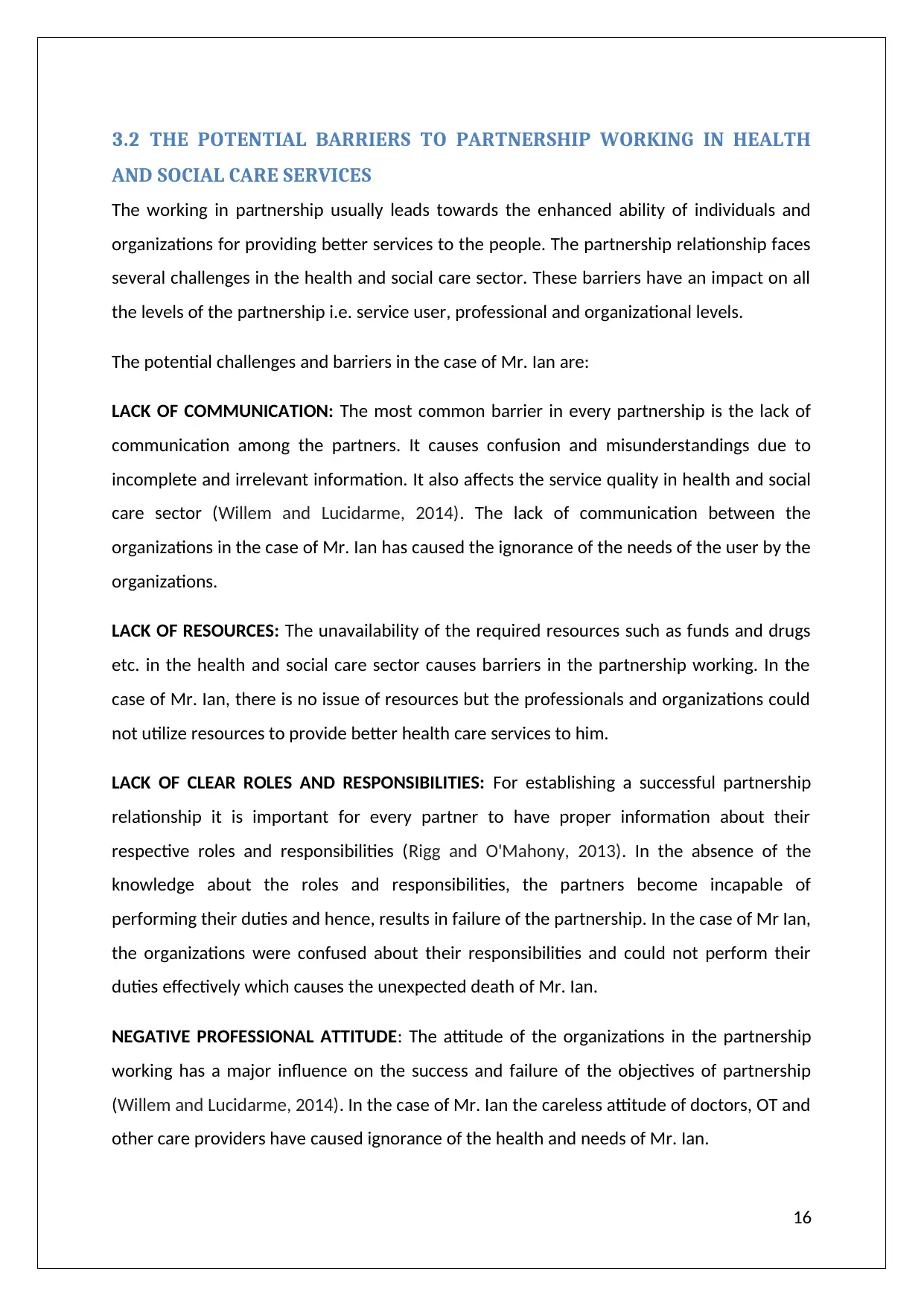
3.2 THE POTENTIAL BARRIERS TO PARTNERSHIP WORKING IN HEALTH
AND SOCIAL CARE SERVICES
The working in partnership usually leads towards the enhanced ability of individuals and
organizations for providing better services to the people. The partnership relationship faces
several challenges in the health and social care sector. These barriers have an impact on all
the levels of the partnership i.e. service user, professional and organizational levels.
The potential challenges and barriers in the case of Mr. Ian are:
LACK OF COMMUNICATION: The most common barrier in every partnership is the lack of
communication among the partners. It causes confusion and misunderstandings due to
incomplete and irrelevant information. It also affects the service quality in health and social
care sector (Willem and Lucidarme, 2014). The lack of communication between the
organizations in the case of Mr. Ian has caused the ignorance of the needs of the user by the
organizations.
LACK OF RESOURCES: The unavailability of the required resources such as funds and drugs
etc. in the health and social care sector causes barriers in the partnership working. In the
case of Mr. Ian, there is no issue of resources but the professionals and organizations could
not utilize resources to provide better health care services to him.
LACK OF CLEAR ROLES AND RESPONSIBILITIES: For establishing a successful partnership
relationship it is important for every partner to have proper information about their
respective roles and responsibilities (Rigg and O'Mahony, 2013). In the absence of the
knowledge about the roles and responsibilities, the partners become incapable of
performing their duties and hence, results in failure of the partnership. In the case of Mr Ian,
the organizations were confused about their responsibilities and could not perform their
duties effectively which causes the unexpected death of Mr. Ian.
NEGATIVE PROFESSIONAL ATTITUDE: The attitude of the organizations in the partnership
working has a major influence on the success and failure of the objectives of partnership
(Willem and Lucidarme, 2014). In the case of Mr. Ian the careless attitude of doctors, OT and
other care providers have caused ignorance of the health and needs of Mr. Ian.
16
AND SOCIAL CARE SERVICES
The working in partnership usually leads towards the enhanced ability of individuals and
organizations for providing better services to the people. The partnership relationship faces
several challenges in the health and social care sector. These barriers have an impact on all
the levels of the partnership i.e. service user, professional and organizational levels.
The potential challenges and barriers in the case of Mr. Ian are:
LACK OF COMMUNICATION: The most common barrier in every partnership is the lack of
communication among the partners. It causes confusion and misunderstandings due to
incomplete and irrelevant information. It also affects the service quality in health and social
care sector (Willem and Lucidarme, 2014). The lack of communication between the
organizations in the case of Mr. Ian has caused the ignorance of the needs of the user by the
organizations.
LACK OF RESOURCES: The unavailability of the required resources such as funds and drugs
etc. in the health and social care sector causes barriers in the partnership working. In the
case of Mr. Ian, there is no issue of resources but the professionals and organizations could
not utilize resources to provide better health care services to him.
LACK OF CLEAR ROLES AND RESPONSIBILITIES: For establishing a successful partnership
relationship it is important for every partner to have proper information about their
respective roles and responsibilities (Rigg and O'Mahony, 2013). In the absence of the
knowledge about the roles and responsibilities, the partners become incapable of
performing their duties and hence, results in failure of the partnership. In the case of Mr Ian,
the organizations were confused about their responsibilities and could not perform their
duties effectively which causes the unexpected death of Mr. Ian.
NEGATIVE PROFESSIONAL ATTITUDE: The attitude of the organizations in the partnership
working has a major influence on the success and failure of the objectives of partnership
(Willem and Lucidarme, 2014). In the case of Mr. Ian the careless attitude of doctors, OT and
other care providers have caused ignorance of the health and needs of Mr. Ian.
16
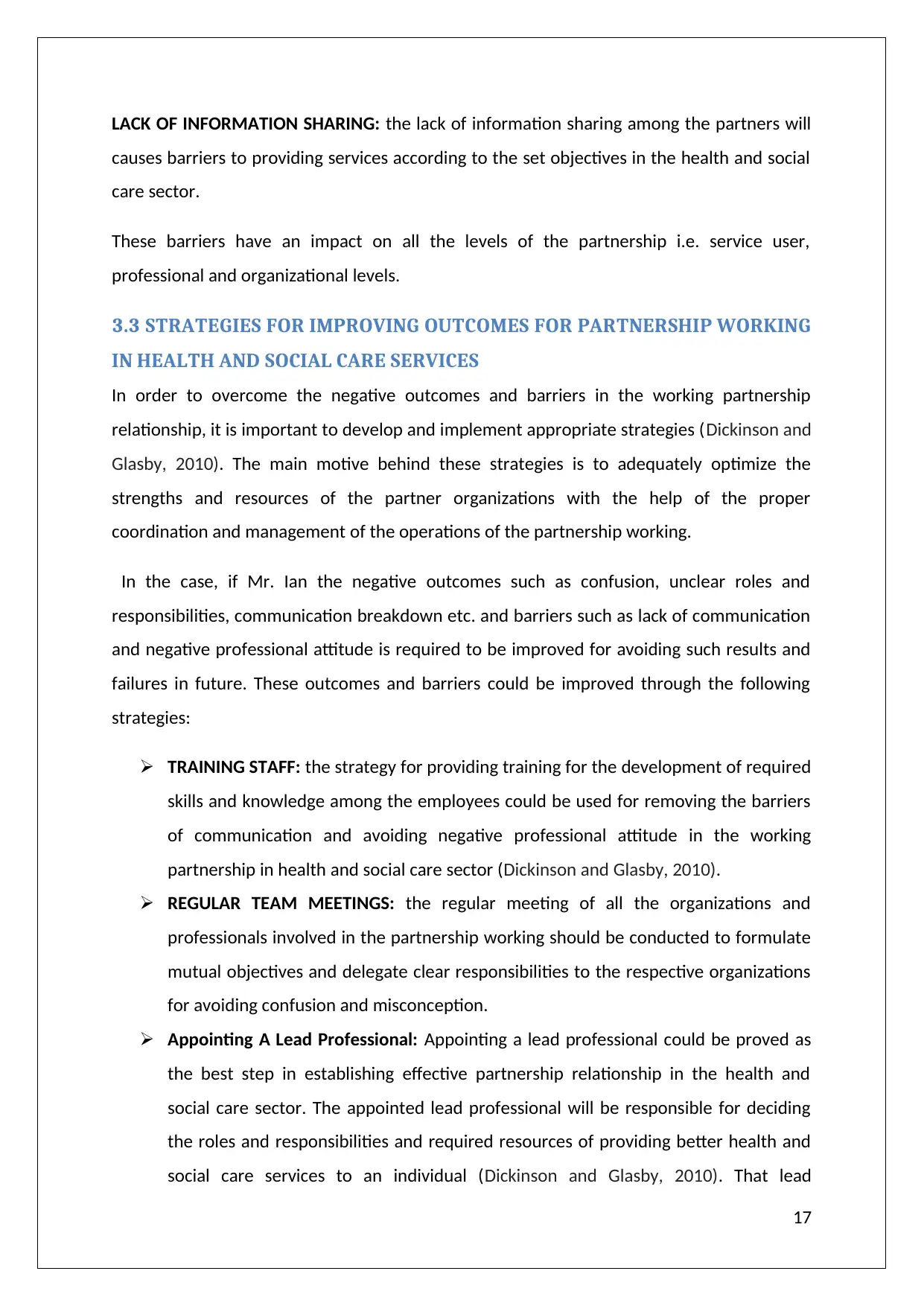
LACK OF INFORMATION SHARING: the lack of information sharing among the partners will
causes barriers to providing services according to the set objectives in the health and social
care sector.
These barriers have an impact on all the levels of the partnership i.e. service user,
professional and organizational levels.
3.3 STRATEGIES FOR IMPROVING OUTCOMES FOR PARTNERSHIP WORKING
IN HEALTH AND SOCIAL CARE SERVICES
In order to overcome the negative outcomes and barriers in the working partnership
relationship, it is important to develop and implement appropriate strategies (Dickinson and
Glasby, 2010). The main motive behind these strategies is to adequately optimize the
strengths and resources of the partner organizations with the help of the proper
coordination and management of the operations of the partnership working.
In the case, if Mr. Ian the negative outcomes such as confusion, unclear roles and
responsibilities, communication breakdown etc. and barriers such as lack of communication
and negative professional attitude is required to be improved for avoiding such results and
failures in future. These outcomes and barriers could be improved through the following
strategies:
TRAINING STAFF: the strategy for providing training for the development of required
skills and knowledge among the employees could be used for removing the barriers
of communication and avoiding negative professional attitude in the working
partnership in health and social care sector (Dickinson and Glasby, 2010).
REGULAR TEAM MEETINGS: the regular meeting of all the organizations and
professionals involved in the partnership working should be conducted to formulate
mutual objectives and delegate clear responsibilities to the respective organizations
for avoiding confusion and misconception.
Appointing A Lead Professional: Appointing a lead professional could be proved as
the best step in establishing effective partnership relationship in the health and
social care sector. The appointed lead professional will be responsible for deciding
the roles and responsibilities and required resources of providing better health and
social care services to an individual (Dickinson and Glasby, 2010). That lead
17
causes barriers to providing services according to the set objectives in the health and social
care sector.
These barriers have an impact on all the levels of the partnership i.e. service user,
professional and organizational levels.
3.3 STRATEGIES FOR IMPROVING OUTCOMES FOR PARTNERSHIP WORKING
IN HEALTH AND SOCIAL CARE SERVICES
In order to overcome the negative outcomes and barriers in the working partnership
relationship, it is important to develop and implement appropriate strategies (Dickinson and
Glasby, 2010). The main motive behind these strategies is to adequately optimize the
strengths and resources of the partner organizations with the help of the proper
coordination and management of the operations of the partnership working.
In the case, if Mr. Ian the negative outcomes such as confusion, unclear roles and
responsibilities, communication breakdown etc. and barriers such as lack of communication
and negative professional attitude is required to be improved for avoiding such results and
failures in future. These outcomes and barriers could be improved through the following
strategies:
TRAINING STAFF: the strategy for providing training for the development of required
skills and knowledge among the employees could be used for removing the barriers
of communication and avoiding negative professional attitude in the working
partnership in health and social care sector (Dickinson and Glasby, 2010).
REGULAR TEAM MEETINGS: the regular meeting of all the organizations and
professionals involved in the partnership working should be conducted to formulate
mutual objectives and delegate clear responsibilities to the respective organizations
for avoiding confusion and misconception.
Appointing A Lead Professional: Appointing a lead professional could be proved as
the best step in establishing effective partnership relationship in the health and
social care sector. The appointed lead professional will be responsible for deciding
the roles and responsibilities and required resources of providing better health and
social care services to an individual (Dickinson and Glasby, 2010). That lead
17
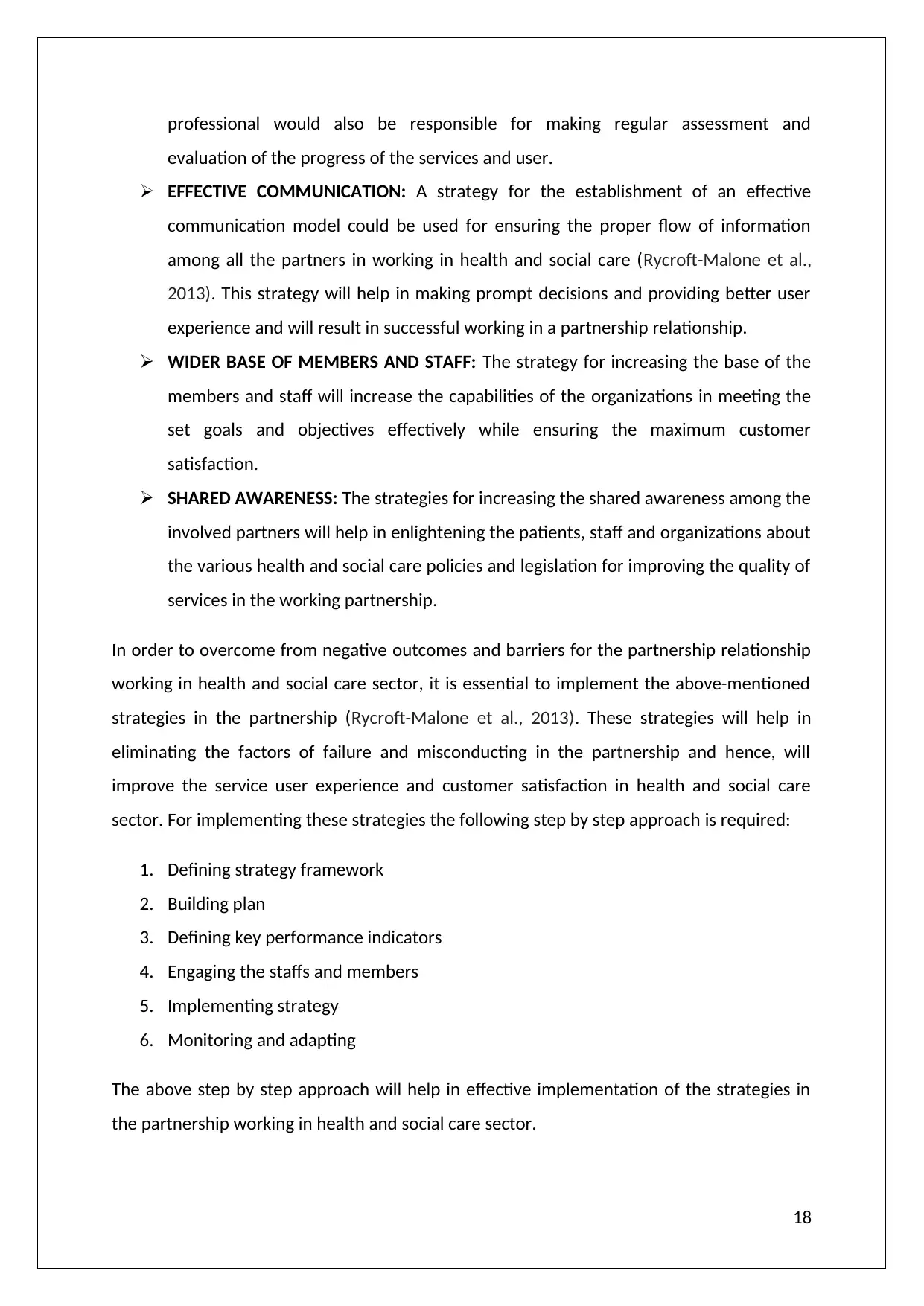
professional would also be responsible for making regular assessment and
evaluation of the progress of the services and user.
EFFECTIVE COMMUNICATION: A strategy for the establishment of an effective
communication model could be used for ensuring the proper flow of information
among all the partners in working in health and social care (Rycroft-Malone et al.,
2013). This strategy will help in making prompt decisions and providing better user
experience and will result in successful working in a partnership relationship.
WIDER BASE OF MEMBERS AND STAFF: The strategy for increasing the base of the
members and staff will increase the capabilities of the organizations in meeting the
set goals and objectives effectively while ensuring the maximum customer
satisfaction.
SHARED AWARENESS: The strategies for increasing the shared awareness among the
involved partners will help in enlightening the patients, staff and organizations about
the various health and social care policies and legislation for improving the quality of
services in the working partnership.
In order to overcome from negative outcomes and barriers for the partnership relationship
working in health and social care sector, it is essential to implement the above-mentioned
strategies in the partnership (Rycroft-Malone et al., 2013). These strategies will help in
eliminating the factors of failure and misconducting in the partnership and hence, will
improve the service user experience and customer satisfaction in health and social care
sector. For implementing these strategies the following step by step approach is required:
1. Defining strategy framework
2. Building plan
3. Defining key performance indicators
4. Engaging the staffs and members
5. Implementing strategy
6. Monitoring and adapting
The above step by step approach will help in effective implementation of the strategies in
the partnership working in health and social care sector.
18
evaluation of the progress of the services and user.
EFFECTIVE COMMUNICATION: A strategy for the establishment of an effective
communication model could be used for ensuring the proper flow of information
among all the partners in working in health and social care (Rycroft-Malone et al.,
2013). This strategy will help in making prompt decisions and providing better user
experience and will result in successful working in a partnership relationship.
WIDER BASE OF MEMBERS AND STAFF: The strategy for increasing the base of the
members and staff will increase the capabilities of the organizations in meeting the
set goals and objectives effectively while ensuring the maximum customer
satisfaction.
SHARED AWARENESS: The strategies for increasing the shared awareness among the
involved partners will help in enlightening the patients, staff and organizations about
the various health and social care policies and legislation for improving the quality of
services in the working partnership.
In order to overcome from negative outcomes and barriers for the partnership relationship
working in health and social care sector, it is essential to implement the above-mentioned
strategies in the partnership (Rycroft-Malone et al., 2013). These strategies will help in
eliminating the factors of failure and misconducting in the partnership and hence, will
improve the service user experience and customer satisfaction in health and social care
sector. For implementing these strategies the following step by step approach is required:
1. Defining strategy framework
2. Building plan
3. Defining key performance indicators
4. Engaging the staffs and members
5. Implementing strategy
6. Monitoring and adapting
The above step by step approach will help in effective implementation of the strategies in
the partnership working in health and social care sector.
18
Paraphrase This Document
Need a fresh take? Get an instant paraphrase of this document with our AI Paraphraser
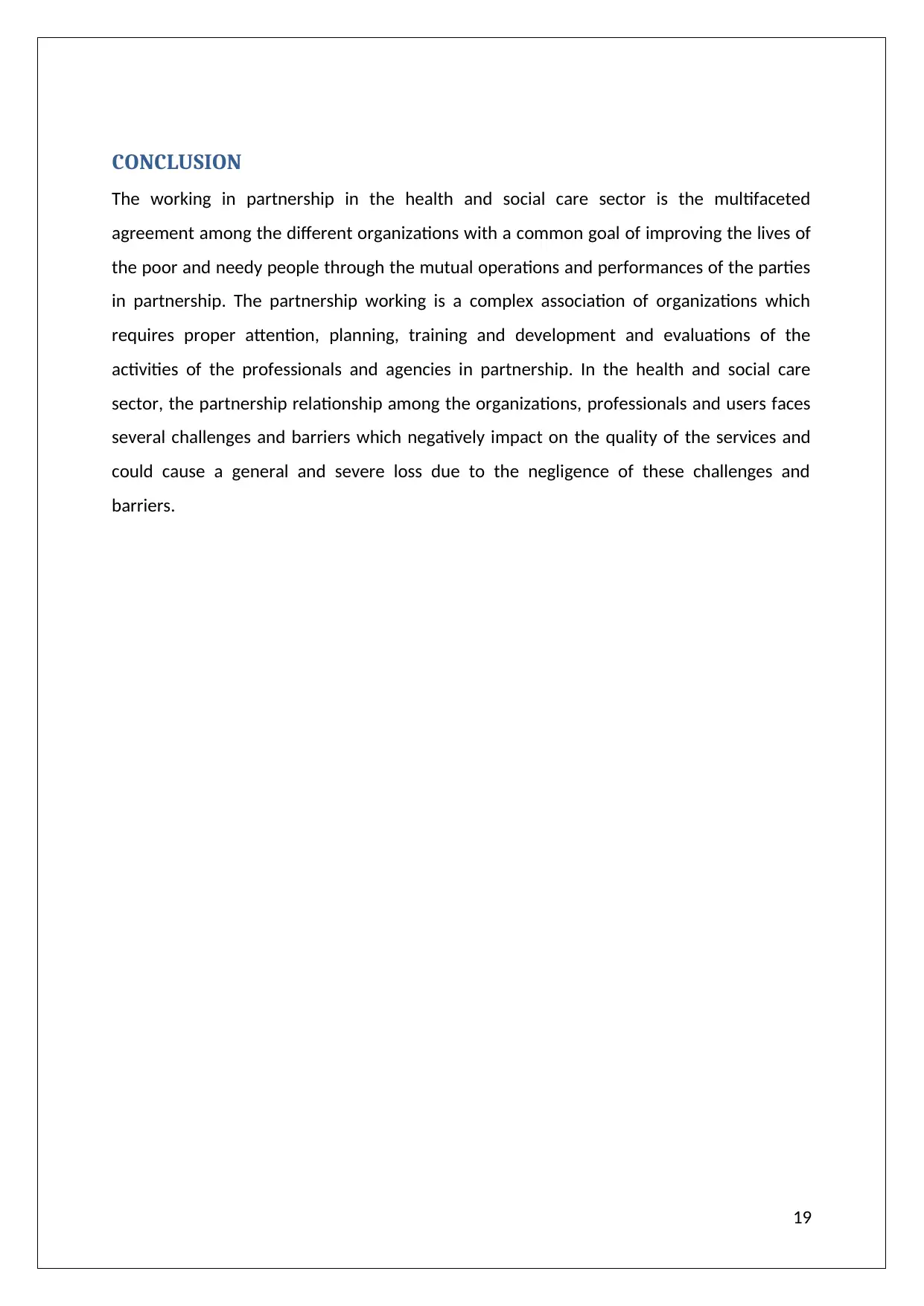
CONCLUSION
The working in partnership in the health and social care sector is the multifaceted
agreement among the different organizations with a common goal of improving the lives of
the poor and needy people through the mutual operations and performances of the parties
in partnership. The partnership working is a complex association of organizations which
requires proper attention, planning, training and development and evaluations of the
activities of the professionals and agencies in partnership. In the health and social care
sector, the partnership relationship among the organizations, professionals and users faces
several challenges and barriers which negatively impact on the quality of the services and
could cause a general and severe loss due to the negligence of these challenges and
barriers.
19
The working in partnership in the health and social care sector is the multifaceted
agreement among the different organizations with a common goal of improving the lives of
the poor and needy people through the mutual operations and performances of the parties
in partnership. The partnership working is a complex association of organizations which
requires proper attention, planning, training and development and evaluations of the
activities of the professionals and agencies in partnership. In the health and social care
sector, the partnership relationship among the organizations, professionals and users faces
several challenges and barriers which negatively impact on the quality of the services and
could cause a general and severe loss due to the negligence of these challenges and
barriers.
19
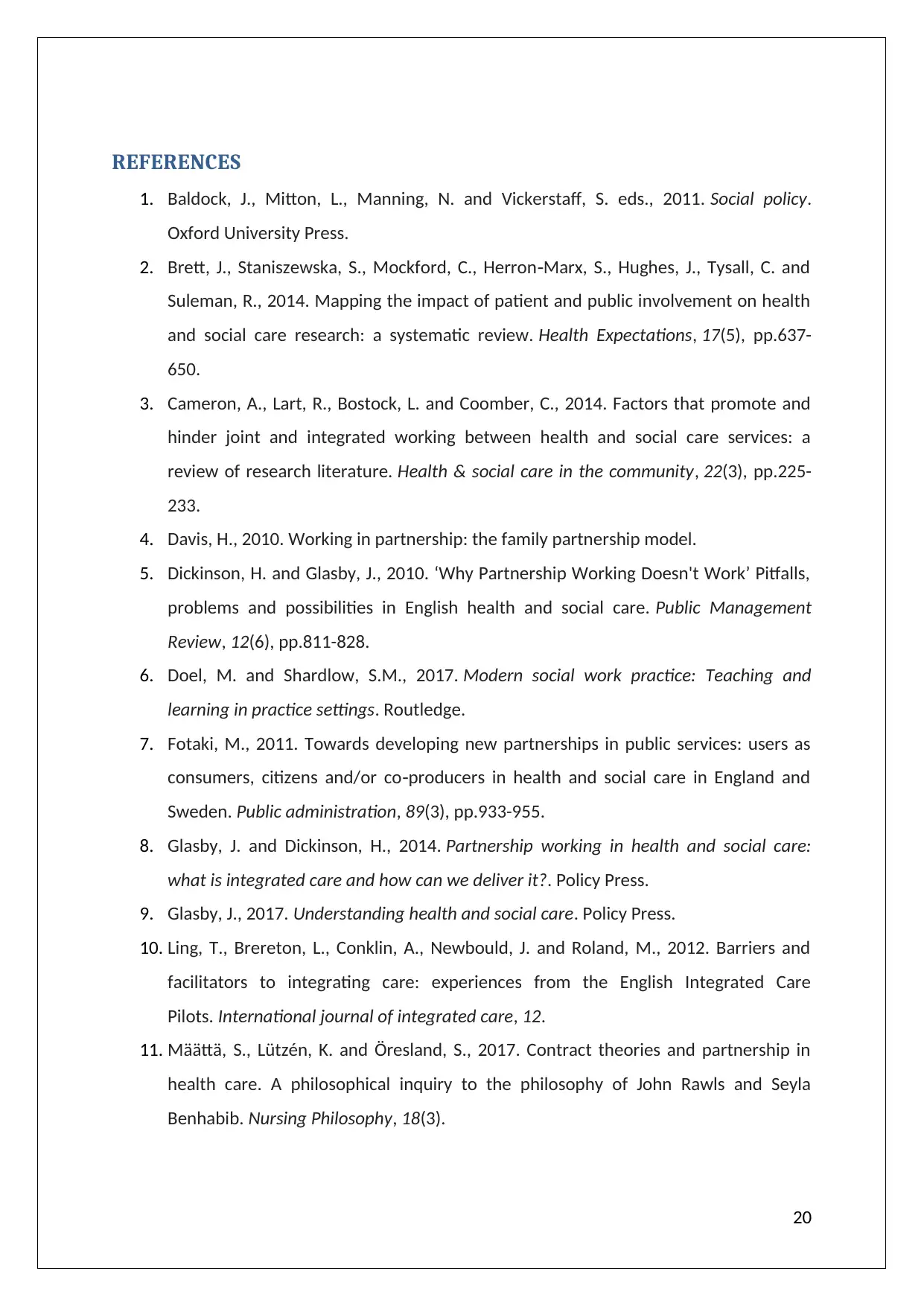
REFERENCES
1. Baldock, J., Mitton, L., Manning, N. and Vickerstaff, S. eds., 2011. Social policy.
Oxford University Press.
2. Brett, J., Staniszewska, S., Mockford, C., Herron Marx, S., Hughes, J., Tysall, C. and‐
Suleman, R., 2014. Mapping the impact of patient and public involvement on health
and social care research: a systematic review. Health Expectations, 17(5), pp.637-
650.
3. Cameron, A., Lart, R., Bostock, L. and Coomber, C., 2014. Factors that promote and
hinder joint and integrated working between health and social care services: a
review of research literature. Health & social care in the community, 22(3), pp.225-
233.
4. Davis, H., 2010. Working in partnership: the family partnership model.
5. Dickinson, H. and Glasby, J., 2010. ‘Why Partnership Working Doesn't Work’ Pitfalls,
problems and possibilities in English health and social care. Public Management
Review, 12(6), pp.811-828.
6. Doel, M. and Shardlow, S.M., 2017. Modern social work practice: Teaching and
learning in practice settings. Routledge.
7. Fotaki, M., 2011. Towards developing new partnerships in public services: users as
consumers, citizens and/or co producers in health and social care in England and‐
Sweden. Public administration, 89(3), pp.933-955.
8. Glasby, J. and Dickinson, H., 2014. Partnership working in health and social care:
what is integrated care and how can we deliver it?. Policy Press.
9. Glasby, J., 2017. Understanding health and social care. Policy Press.
10. Ling, T., Brereton, L., Conklin, A., Newbould, J. and Roland, M., 2012. Barriers and
facilitators to integrating care: experiences from the English Integrated Care
Pilots. International journal of integrated care, 12.
11. Määttä, S., Lützén, K. and Öresland, S., 2017. Contract theories and partnership in
health care. A philosophical inquiry to the philosophy of John Rawls and Seyla
Benhabib. Nursing Philosophy, 18(3).
20
1. Baldock, J., Mitton, L., Manning, N. and Vickerstaff, S. eds., 2011. Social policy.
Oxford University Press.
2. Brett, J., Staniszewska, S., Mockford, C., Herron Marx, S., Hughes, J., Tysall, C. and‐
Suleman, R., 2014. Mapping the impact of patient and public involvement on health
and social care research: a systematic review. Health Expectations, 17(5), pp.637-
650.
3. Cameron, A., Lart, R., Bostock, L. and Coomber, C., 2014. Factors that promote and
hinder joint and integrated working between health and social care services: a
review of research literature. Health & social care in the community, 22(3), pp.225-
233.
4. Davis, H., 2010. Working in partnership: the family partnership model.
5. Dickinson, H. and Glasby, J., 2010. ‘Why Partnership Working Doesn't Work’ Pitfalls,
problems and possibilities in English health and social care. Public Management
Review, 12(6), pp.811-828.
6. Doel, M. and Shardlow, S.M., 2017. Modern social work practice: Teaching and
learning in practice settings. Routledge.
7. Fotaki, M., 2011. Towards developing new partnerships in public services: users as
consumers, citizens and/or co producers in health and social care in England and‐
Sweden. Public administration, 89(3), pp.933-955.
8. Glasby, J. and Dickinson, H., 2014. Partnership working in health and social care:
what is integrated care and how can we deliver it?. Policy Press.
9. Glasby, J., 2017. Understanding health and social care. Policy Press.
10. Ling, T., Brereton, L., Conklin, A., Newbould, J. and Roland, M., 2012. Barriers and
facilitators to integrating care: experiences from the English Integrated Care
Pilots. International journal of integrated care, 12.
11. Määttä, S., Lützén, K. and Öresland, S., 2017. Contract theories and partnership in
health care. A philosophical inquiry to the philosophy of John Rawls and Seyla
Benhabib. Nursing Philosophy, 18(3).
20
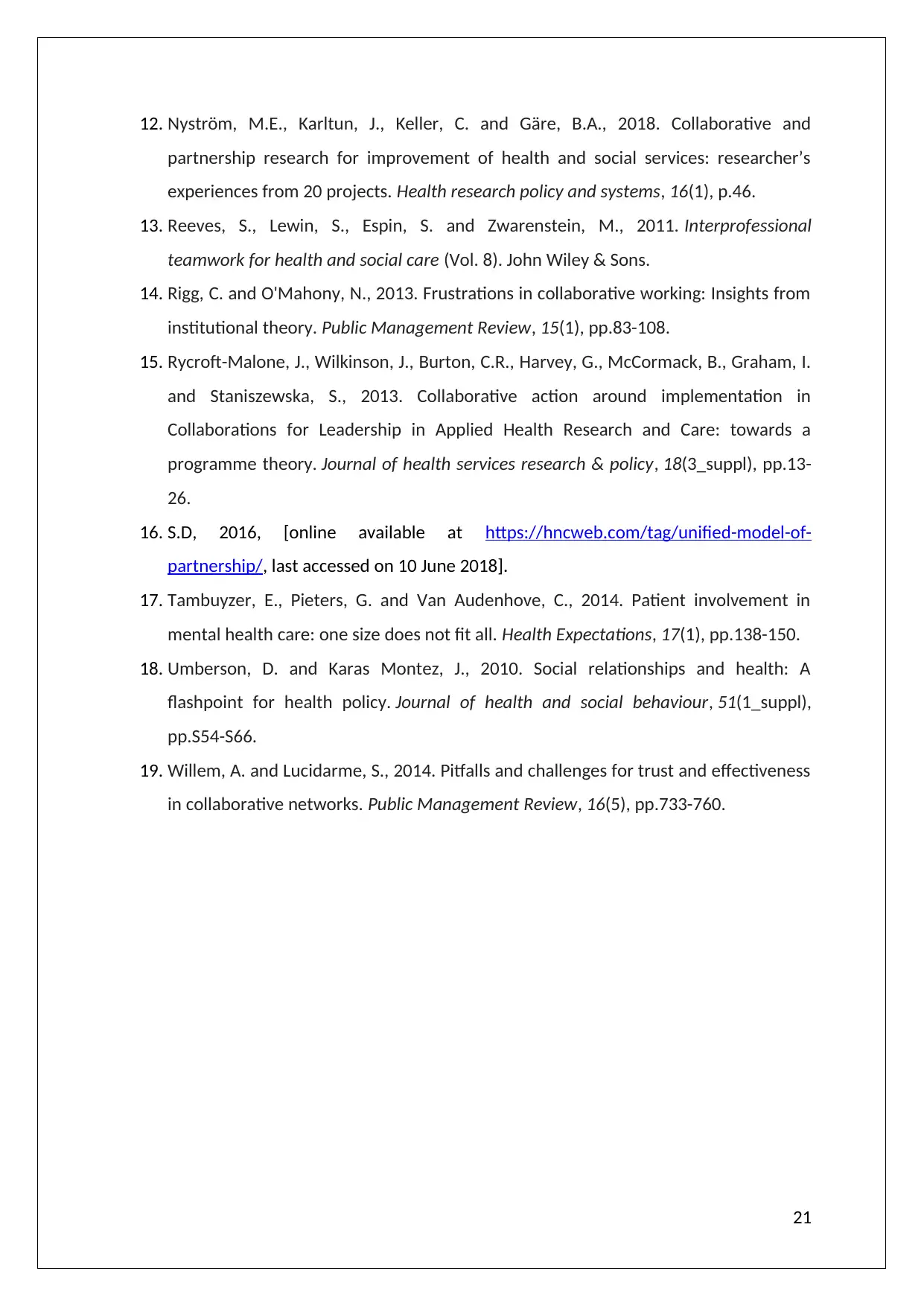
12. Nyström, M.E., Karltun, J., Keller, C. and Gäre, B.A., 2018. Collaborative and
partnership research for improvement of health and social services: researcher’s
experiences from 20 projects. Health research policy and systems, 16(1), p.46.
13. Reeves, S., Lewin, S., Espin, S. and Zwarenstein, M., 2011. Interprofessional
teamwork for health and social care (Vol. 8). John Wiley & Sons.
14. Rigg, C. and O'Mahony, N., 2013. Frustrations in collaborative working: Insights from
institutional theory. Public Management Review, 15(1), pp.83-108.
15. Rycroft-Malone, J., Wilkinson, J., Burton, C.R., Harvey, G., McCormack, B., Graham, I.
and Staniszewska, S., 2013. Collaborative action around implementation in
Collaborations for Leadership in Applied Health Research and Care: towards a
programme theory. Journal of health services research & policy, 18(3_suppl), pp.13-
26.
16. S.D, 2016, [online available at https://hncweb.com/tag/unified-model-of-
partnership/, last accessed on 10 June 2018].
17. Tambuyzer, E., Pieters, G. and Van Audenhove, C., 2014. Patient involvement in
mental health care: one size does not fit all. Health Expectations, 17(1), pp.138-150.
18. Umberson, D. and Karas Montez, J., 2010. Social relationships and health: A
flashpoint for health policy. Journal of health and social behaviour, 51(1_suppl),
pp.S54-S66.
19. Willem, A. and Lucidarme, S., 2014. Pitfalls and challenges for trust and effectiveness
in collaborative networks. Public Management Review, 16(5), pp.733-760.
21
partnership research for improvement of health and social services: researcher’s
experiences from 20 projects. Health research policy and systems, 16(1), p.46.
13. Reeves, S., Lewin, S., Espin, S. and Zwarenstein, M., 2011. Interprofessional
teamwork for health and social care (Vol. 8). John Wiley & Sons.
14. Rigg, C. and O'Mahony, N., 2013. Frustrations in collaborative working: Insights from
institutional theory. Public Management Review, 15(1), pp.83-108.
15. Rycroft-Malone, J., Wilkinson, J., Burton, C.R., Harvey, G., McCormack, B., Graham, I.
and Staniszewska, S., 2013. Collaborative action around implementation in
Collaborations for Leadership in Applied Health Research and Care: towards a
programme theory. Journal of health services research & policy, 18(3_suppl), pp.13-
26.
16. S.D, 2016, [online available at https://hncweb.com/tag/unified-model-of-
partnership/, last accessed on 10 June 2018].
17. Tambuyzer, E., Pieters, G. and Van Audenhove, C., 2014. Patient involvement in
mental health care: one size does not fit all. Health Expectations, 17(1), pp.138-150.
18. Umberson, D. and Karas Montez, J., 2010. Social relationships and health: A
flashpoint for health policy. Journal of health and social behaviour, 51(1_suppl),
pp.S54-S66.
19. Willem, A. and Lucidarme, S., 2014. Pitfalls and challenges for trust and effectiveness
in collaborative networks. Public Management Review, 16(5), pp.733-760.
21
1 out of 22
Related Documents
Your All-in-One AI-Powered Toolkit for Academic Success.
+13062052269
info@desklib.com
Available 24*7 on WhatsApp / Email
![[object Object]](/_next/static/media/star-bottom.7253800d.svg)
Unlock your academic potential
© 2024 | Zucol Services PVT LTD | All rights reserved.




